JUNE-JULY 2024
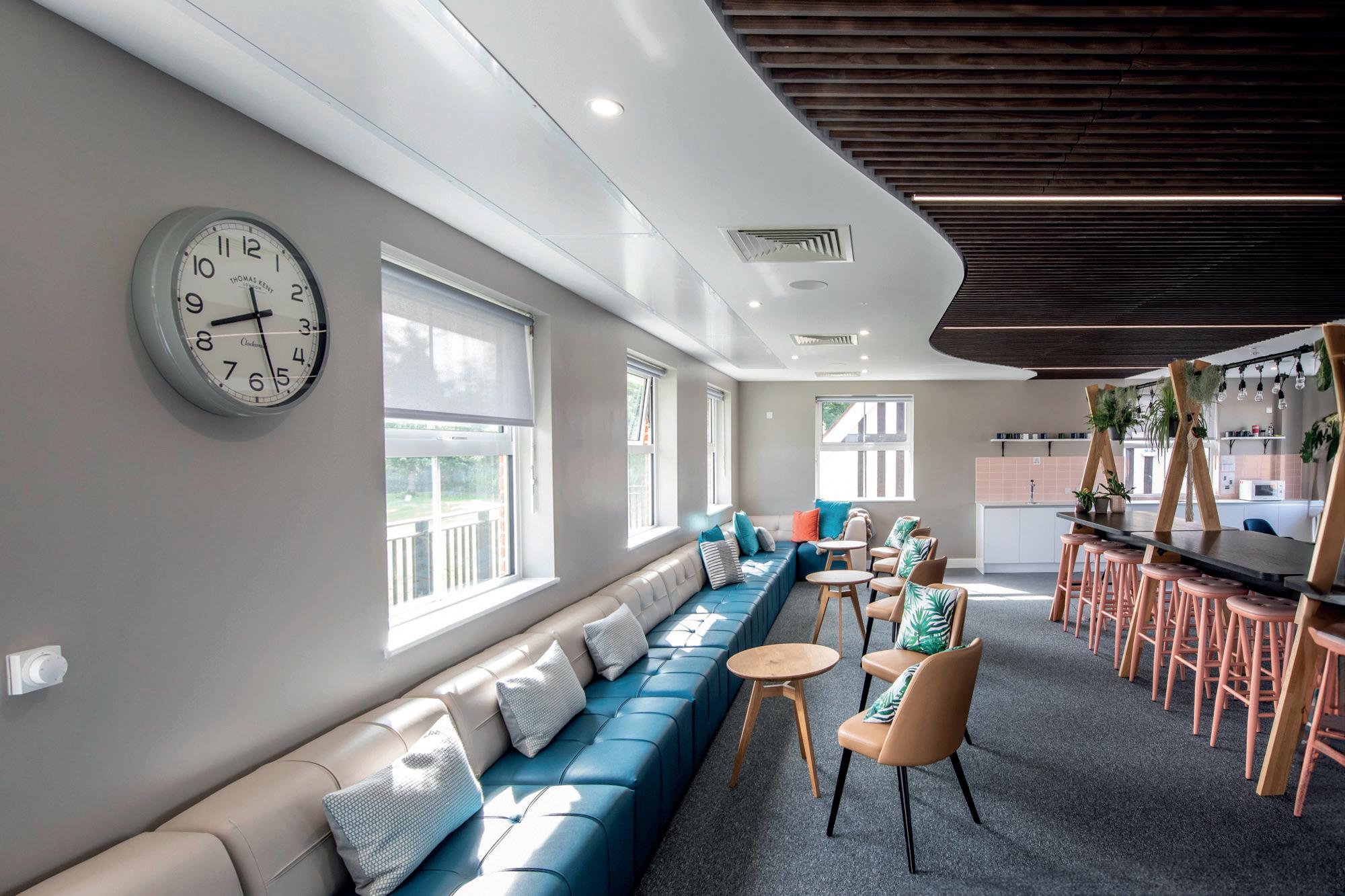

Special report on the latest acoustic treatments to address noise pollution in schools
Study reveals the impact of lighting on children with special educational needs
Nurseries launch petition to force government to axe business rates levy
EDUCATION-PROPERTY.COM
06/2024







The impact of the learning environment WELCOME
While quality of learning is dependent to a high degree on the quality of teaching, the environment also has a significant impact on students and staff.
Issues such as noise pollution and lighting can have a considerable detrimental effect on concentration and behaviour, particularly among neurodiverse children.
And these are areas we are focusing on in this edition of Education Property.
Speaking to experts, we examine the challenges raised by poor acoustics and lighting levels seen in many schools, even those built relatively recently.
We also look at the ways these problems can be overcome using the most-up-to-date tools and technologies.

In this edition there is also a special report on the Government’s recent expansion of funding for early years childcare and the potential impact this could have on the nursery estate, with operators looking to invest in new properties to meet the anticipated increase in demand.
And we consider the ramifications of the Labour Party’s plans to charge VAT on private school fees and
report on a petition by early years providers to force the Government to abolish business rates for nurseries.
In a sector which is grossly underfunded, but absolutely critical, it is clear that more needs to be done to ensure its long-term success and this has got to be done in conjunction with industry.
Moving forward, Education Property will continue to highlight these challenges and opportunities, utilising expert opinion and insight to discover some of the solutions.
Coming up in the next edition, we will be looking at the design of multi-use games areas (MUGAs), security solutions for educational settings, and how offsite construction methods are increasingly being used to deliver science facilities.
If you can help, please contact joanne.makosinski@nexusgroup.co.uk
Jo Makosinski Editor Education Property
About Jo: Jo is the editor of Education Property, having joined Nexus Media in November.
She has been specialising in design and construction best practice for the past 14 years, working on the Building Better Healthcare Awards and editing both
Building Better Healthcare and Healthcare Design & Management magazines.
She has a special interest in the design of public buildings including schools, nurseries, colleges, hospitals, health centres, and libraries.
Comment EDUCATION-PROPERTY.COM JUNE-JULY 2024 | 3


6-9 News
We round up the latest big stories, including a proposed review of higher education funding, changes to student accommodation rental rules, and plans for a major overhaul of the SEND education estate in Northern Ireland

12-13 Policy
Exploring government plans to change the admissions rules for faith schools; and reforming additional learning needs (ALN) support in Wales



Building Design and Construction
Special report exploring the key role acoustic treatments play in creating more-effective learning environments. We also profile a new collaborative Health

38-42 Estates and Facilities Management
14-24 Finance and Property
An overview of the key trends in real estate financing for the education sector, including discussing the implications of the early years entitlement expansion; a petition lobbying for nurseries to be exempt from paying business rates; and VAT charges on private schools. Plus, we highlight some of the main findings of a worrying new finance report from the Education Policy Institute and look at the latest education property deals
44-48
The ways in which technology such as floor-cleaning robots can help to keep educational facilities clean, the nine challenges facing EFM professionals, and Litmus partners with AUDE to support estates managers
Environmental
The critical role of flexible financing in supporting higher education sustainability goals, and why planned new schools may be built in areas of high pollution
49-50
People
Staffing and people news, including the latest industry appointments
12 28 38 20
The future of higher education funding
The Office for Students (OfS) has launched a call for evidence for views on how it applies its powers to distribute funding to universities and colleges in England.
Each year, the OfS distributes around £1.4bn through the Strategic Priorities Grant, which supports teaching and related activities at universities and colleges.
The OfS also distributes capital funding to support the building and renovation of facilities, including laboratories, specialist teaching suites, and lecture halls.
And, recently, it allocated £450m of capital funding for the 2022-23 to 2024-25 financial years.
The OfS’s existing method of distributing funding recognises the additional costs to universities and colleges that may be associated with teaching particular courses or supporting students, such as those from disadvantaged backgrounds, to access and succeed in higher education.
The approach also accounts for strategic priorities in higher education, including supporting priority subjects and helping students to continue and complete their studies and go onto successful outcomes after graduation.
Through the call for evidence, the OfS is keen to hear how its approach to distributing funding can better support universities and colleges to deliver a highquality education experience for students.
The call asks:
• What should the OfS be seeking to achieve with the funding it allocates, and how might its funding adapt in the future?
• What factors should the OfS consider when making judgements about the strategic priority of a course or subject area?
• Are there areas of important provision that are not currently supported by OfS funding that could be considered in future?
The OfS also wants to hear how its funding powers should be applied to support capital investment, national facilities, and specialist higher education providers, with respondents being asked:
• What are your views on these types of OfS funding?
• What is the impact of these types of OfS funding?
Commenting on the call for evidence, John Blake, director for fair access and participation at the OfS, said: “The OfS is responsible for distributing millions into universities and colleges each year to support students’ learning, strategicallyimportant courses, and specialist higher education providers.

others who are interested or impacted by these funding decisions, to share their views.
“We recognise that the higher education landscape has changed a lot in the years since our current approach was established.
“Could our funding be better targeted to support equality of opportunity for students? What specific types of work are
Budget settlement falls short
The Northern Ireland Executive has admitted its allocation of £2.6bn for education providers for the 2024/25 financial year ‘won’t provide sufficient funding for the Department for Education to do everything it wants’.
Confirming its budget for the 2024-25 financial year, which also includes an additional £254.3m in education capital funding, Dr Caoimhe Archibald, Northern Irish Finance Minister, said: “Since devolution was restored, we have been really clear this was always going to be a difficult budget.
“The stark reality is the demands on our finances far outstrip the funding available many times over.
“No department has received the level of funding it has bid for. As an Executive, we have had to make tough choices and prioritise the funding envelope we have.
“With increased demands on services and rising costs, I recognise these allocations won’t provide sufficient funding for departments to do everything they want — that is regrettable for all Executive ministers.”
She added: “The Budget underlines our commitment to health, with it receiving over half of the total amount allocated to departments for day-to-day costs, including £34m to tackle waiting lists, while education has received almost a fifth of the funding.
“These responses will provide important insight to ensure our approach to distributing this funding meets our priorities, and those of the higher education providers it supports, to deliver a high-quality education experience for all students.
‘We will carefully consider all the responses and evidence we receive as we look to develop our future approach.”
The call for evidence closed on 23 May.
“Recognising the importance of a childcare strategy, £25m is being set aside for this.”
Responding to the settlement, Richard Pengelly, chief executive of the Education Authority, which delivers all education services in the region, said: “I don’t think anyone in public service provision is under any illusions that it’s going to be incredibly difficult.
“There are some critical issues across the education sector and I think they haven’t had the level of investment they should have had in recent years, and I think unless we’re careful, that will start to appear on the frontline, some real cracks … things like levels of digital investment, IT security.”
6 | JUNE-JULY 2024 EDUCATION-PROPERTY.COM News
Students slam ‘unforgivable’ rental reform plans
Higher education and student housing organisations have hit out at the Government’s long-awaited plans to review Britain’s property rental system, claiming it will threaten the availability, affordability, and quality of student housing across the country.
The Renters (Reform) Bill received its third reading in the House of Commons in April, aims to deliver on the Government’s commitment to ‘bring in a better deal for renters’, including abolishing section 21 ‘no fault’ evictions and reforming landlord possession grounds.
It will also legislate for reforms set out in the Private Rented Sector White Paper published in June 2022.
However, since it was first put in front of politicians more than 200 amendments have been made and the protection originally offered to students has been ‘watered down’, critics claim.
Originally, the bill only allowed landlords who were letting purpose-built student accommodation to serve a Section 8 notice eviction for a legal reason
Now they are able to serve eviction notices on all students, including those in the private rented sector.
The National Union of Students (NUS) this week accused the Government of ‘folding to landlords’ lobbying’.

NUS UK vice president for higher education, Chloe Field, said: “The Renters’ (Reform) Bill was an exciting piece of legislation which promised to reform Britain’s archaic rental system and provide long-needed protections to renters.
“But right from the get-go landlords who let properties to students lobbied to have them excluded from the protections offered to other tenants.
“NUS and the student movement were delighted when the Bill was placed before Parliament intact, with no student exemption to its safeguards.
“But, as the Bill made its way through the Parliamentary process, we became aware of a continuing and concerted campaign to force the Government to create an unprecedented two-tier rental market, where students would be at the mercy of Section 21 evictions that other tenants would be protected from.”
She added: “The student housing market is broken, as is our higher education system.
“The Renters’ (Reform) Bill was the one concrete thing the Government had to offer us.
“It promised long-needed reforms which would lead to securer tenancies and a market much more in tune with student tenant needs.
“To have the Government throw this away and ensure that landlords continue to have all the power is unforgiveable.”
In letters to a government minister and the Labour Party, seven higher education and student housing groups, including Universities UK, Unipol, and Nottingham Trent University, warned that plans to end fixed-term tenancy agreements (FTTAs) for private student housing would threaten the availability, affordability, and quality of student housing across the country.
This is despite the latest amendment to the Bill dictating that student housing will be given a new ground for possession so student landlords can retain the annual cycle of student tenants.
The group, Student Accredited Private Rental Sector (SAPRS), said the bill must now be amended to ensure parity between purpose-built student accommodation and private student housing to avoid worsening the student housing crisis, provided that landlords sign up to an approved code of conduct with quality standards and protections for students.
Calum MacInnes, chair of the SAPRS, said: “Anything less than parity with the way the Bill treats the purpose-built student accommodation sector is just not enough.
“With the pressure of end-of-year exams and coursework, the next few months will be incredibly challenging for students as it is.
“The Government must ensure the Renters (Reform) Bill recognises the situation and offers security for private student housing.”
The Bill will now make its way through the House of Lords, where it will face further scrutiny by peers.
News EDUCATION-PROPERTY.COM JUNE-JULY 2024 | 7
SEN schools receive funding
More than half a billion pounds will be invested in the education estate in Northern Ireland as part of plans to provide better support for children with Special Educational Needs (SEN).
Education Minister, Paul Givan, has announced a wide-ranging programme of significant and sustained capital investment for the development of SEND school facilities across Northern Ireland.
Speaking in the Assembly, he said:
“Today I am announcing the biggest step change to capital planning in education for a generation, with an ambitious and far-reaching programme of investment in facilities for children with SEN, which will transform the education and lives of our most-vulnerable children and their families.
“It is simply not good enough that many of our most-vulnerable children are being educated in ageing facilities, too often without adequate equipment and resources.
“Our special school staff, who work with our most-vulnerable learners, need and deserve facilities that match their skills and expertise.”

The new SEN Capital Programme will deliver up to eight entirely-new special schools over the next 10 years; new builds for a number of existing special schools; an extension and refurbishment programme for special schools; and accommodation for specialist classes in mainstream schools, as well as additional maintenance and equipment funding.
Outlining a four-point capital investment masterplan that will benefit every special school in Northern Ireland, the Minister continued: “I have put in place an annual £5m maintenance programme for special schools as well as £4m to provide equipment grants to both special schools
A healthy pipeline of projects
Watson Batty Architects has announced it will lead on a number of new education projects across the UK.
Since the Government committed to increase its allocation for upgrading schools, which includes £1.8bn for the 202425 financial year, the practice has reported a surge in business that now accounts for 32% of the company’s total turnover.
This includes major new-build projects for national contractors including Tilbury Douglas, ISG, and modular building specialist, Algeco UK.
and schools with specialist provisions to ensure they have the right resources to support their pupils.”
And he announced that planning of newbuild schools for Sperrinview and Knockevin special schools would begin immediately, as too will capital planning for the muchneeded second campus at Ardnashee Special School.
He said: “Our hopes and ambitions for our children with SEN should be the same as for any other child.
“This programme of capital investment is wide ranging and necessarily ambitious and will transform the special education provision in Northern Ireland.”
The SEN Capital Programme will have four distinct strands:
• An annual ring-fenced resource maintenance and equipment programme for special schools
• Creation of additional Specialist Provision in Mainstream Schools classes (SPiMS)
• Extension of existing special schools to provide additional places
• New special school provision

science, and engineering facilities.

Recent instructions include the design and delivery contract for a new science block at Saint Benedict Catholic Voluntary Academy in Derby; and a new 1,200-place school for the Northampton School for Boys.
And planning consent was recently secured for a replacement school at Beacon Academy in Cleethorpes, Tees Valley SEND School, and Leeds City Academy, with works also due to commence on a replacement building for Hempland Primary School in York.
In addition, Watson Batty is working with the University of Leeds, Leeds Becket University, and Loughborough University to provide several new specialist health,
Peter White, managing director, said: “We are a 48-year-old, award-winning practice with considerable skills in all manner of projects across all built environment sectors. However, in recent years we have honed our ‘learning’ sector expertise in line with the Department for Education procurement strategy and formed strategic partnerships with a number of contractors to secure a strong pipeline.
“It is rewarding to see the growth of net-zero carbon in operation projects in our education portfolio with a fabric-first approach taking precedent.
“We see strong potential in delivering better educational facilities, and in particular much-needed SEND provisions, nationally
through upgrading existing stock and with the aid of modern methods of construction.
“Indeed, the recent £850m cash pledge by Government to improve accessibility for people with SEND is driving new upgrades to existing estates nationwide.”
Watson Batty designed The Vine SEND college for Leeds City Council with a particularly-challenging brief to support students with severe disabilities.
The now-completed two-storey building allows students to access a broad curriculum and specialist spaces including rebound therapy, a physiotherapy suite, sensory rooms, hydrotherapy pool, and extensive life-skills centre.
8 | JUNE-JULY 2024 EDUCATION-PROPERTY.COM News
Nursery sector calls for stricter food standards
Industry leaders are calling on the Government to deliver stricter, clearer, and morespecific food standards for early years settings following a survey that found that over 50% of parents rely heavily on their nursery to feed their children nutritious meals.
Over 10 industry leaders, representing more than 150 early years settings across the UK, have submitted a joint letter to government leaders calling for action to turn the tide on nationwide childhood health and obesity issues.
The letter highlights that, with increasing access to free childcare, more and more parents of children under the age of five will become reliant on early years settings to provide nutritious meals.
The campaign comes as a OnePoll survey found that nearly 70% of parents were unaware that there are no governmentbacked regulations on what

nutritious food should consist of in early years settings. And almost 90% of parents agreed that the Government should do more to ensure children in nursery are being fed well.
Jonny Player, managing director at Nursery Kitchen, is leading the campaign and said: “The health of our children must become an important discussion in Parliament.
“Early years settings are becoming increasingly responsible for feeding young children and ensuring Britain’s next generation lead healthy and happy lives.
“As industry leaders, we are in agreement that our organisations, large and small, must have strong policies in place that recognise the importance of proper nutrition in early years settings, but we need political leadership to act on the state of the nation’s health now, and instruct lasting change.”
University nursery set to open
Tilbury Douglas has handed over a new nursery at the University of York, increasing the childcare provision on campus for staff, students, and local families.
The purpose-built facility, which is located opposite York Sports Village, provides care for more than 90 children in Heslington.
York Campus Nursery includes five age-appropriate rooms, each with its own dedicated indoor and landscaped outdoor play areas, bike and buggy stores, and dropoff parking.
Paul Ellenor, regional director for Yorkshire and the North East at Tilbury Douglas, said: “We are delighted to have successfully completed this new nursery building, helping the university deliver on its commitment to provide an excellent childcare provision for its staff and students, and growing links with the local community.”
During the project the Tilbury Douglas team hosted two T-Level placements
The letter, sent to 19 government representatives, calls for a revision to the Early Years Foundation Stage statutory framework, to expand the food section, providing clear standards for ‘nutritious’ meals.
Leaders also ask for the Eat Better, Start Better programme to be reviewed to encourage early years settings to invest in and see high-quality, healthy food as a priority.
And a letter sent to Kier Starmer, urges Labour to give specific attention to early years settings in its Child Health Action Plan, which promises the healthiest generation of children ever, but does not acknowledge challenges at pre-school age.
Sarah Steel, chair of the Old Station Nursery, said: “We are proud to get behind this campaign, which we know will only improve our children’s long-term health, providing we all work together to face these challenges head on.
“Our children deserve to have the very-best start in life and that must begin with good nutrition — a basic, but fundamental, part of early development.
“We are coming together as an industry with a view that we can achieve real change for the better.”
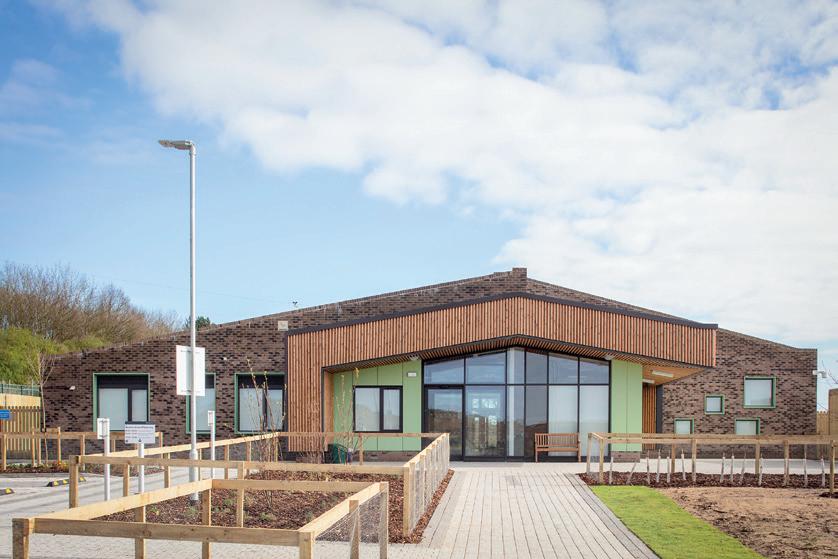
and a site visit for York College students, as well as taking part in the Skills for Life Apprenticeship Fair in York.
In addition, team members took part in a digital volunteering day for a local community group, and at the start of the project arranged a visit from Father Christmas for children at the existing nursery.
Dr Joss Ivory, chief operating officer at the University of York, said: “We are delighted to have welcomed the first children to our amazing new nursery in Kimberlow Lane.
“The facility demonstrates a significant investment and commitment to providing exceptional childcare for children from the

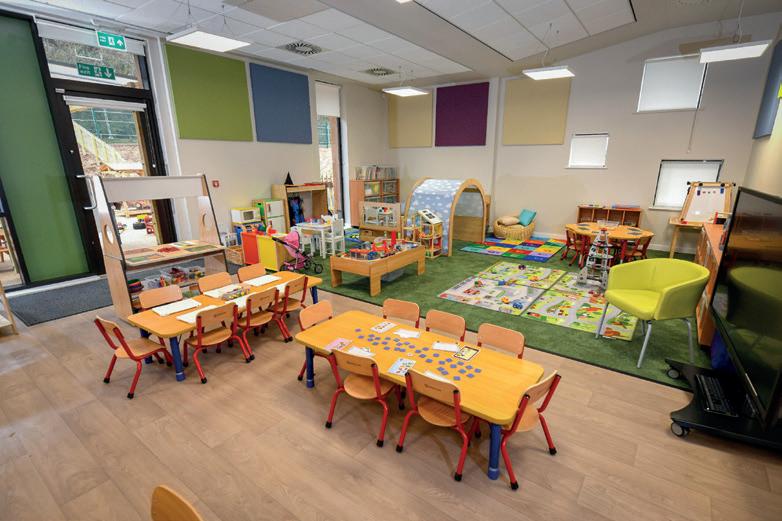
local area and University of York community.
“We are incredibly grateful to the delivery team and our staff for the passion and commitment shown throughout the project and we look forward to the years ahead and supporting new and existing families in our outstanding new nursery.”
News EDUCATION-PROPERTY.COM JUNE-JULY 2024 | 9
Ceremony marks start of work on new high school
A ground-breaking ceremony has been held to mark the start of work on the replacement Liberton High School in Edinburgh.
The school is being constructed by Balfour Beatty to Passivhaus standards and is due to be completed in early 2026, with the old school then being demolished within a year.
The school will have capacity for 1,200 pupils with classrooms, studios, workshops, and science labs connected to shared collaborative areas and breakout spaces, providing learners with more personalisation and a choice over their learning environment.
Associated sports facilities will include a floodlit multiuse games area, basketball court, and athletics facilities.
The current tennis and beach volleyball courts and mountain bike trail will be retained as will the sports block and a new fitness suite and dance studio will be provided to complement the existing facilities.
The building has been designed to be highly energy efficient and will utilise high-performance windows and doors and mechanical ventilation with heat recovery to reduce carbon emissions, improve indoor air quality, and decrease heating bills.
A key part of the new school will be the community campus features as it will include non-educational facilities such as a café, library, and flexible workspaces.
Hector MacAulay, managing director of Balfour Beatty Scotland, was joined by headteacher, Alison Humphreys, at the ground-breaking ceremony, with current school pupils and representatives from the City of Edinburgh

Council and the Scottish Government also in attendance.
MacAulay said: “It was an honour to join with colleagues and pupils from Liberton High School today to mark this important occasion.
“As we embark on the next phase of the project with construction now underway, we remain committed to delivering a modern, safe, and sustainable learning estate that will enhance and support communities and improve the lives of families in the local area.”
Councillor Joan Griffiths, education, children, and families convener at the City of Edinburgh Council, added: “Our new school campuses are innovatively and sustainably designed so they are inspirational places for learning for the next generation of young people, creating a vibrant and thriving learning environment.
“The Liberton Community Campus is a really-exciting project which provides an amazing opportunity to create a community lifelong learning and sports hub to replace the existing school.
“This means public services can be co located with links to active travel networks, green infrastructure, and public transport networks.”
£70m education campus project gets underway
Work will begin next week on the first phase of a £70m project to build the new Ballycastle Shared Education Campus in Northern Ireland.
The Department for Education has appointed Heron Bros contractors to build the modern, state-ofthe-art facility, which will be shared between Ballycastle High School and Cross and Passion College and will be
funded primarily through Fresh Start funding for Shared and Integrated Education.
The new campus will accommodate approximately 1,200 pupils from both schools and will be constructed on the existing school sites.
The first phase of construction work will see the creation of a hockey pitch, multi-use games area (MUGA), and main school building.

The work is expected to take two years and will be followed by the construction of a sports building, with completion of all works expected by the summer of 2027.
The main campus building and sports hall will be located
on the current Ballycastle High School site, while the Cross and Passion site will accommodate outdoor sports facilities and a changing pavilion.
Samuel Stevenson & Sons has provided design consultancy for the project.

10 | JUNE-JULY 2024 EDUCATION-PROPERTY.COM News








Kristine Scott Harrison Clark Rickerby “Go Commercial! The benefits of ditching charitable status and how to go about it” Sir Anthony Seldon Durell Barnes The implementation of the Independent Schools Inspectorate's new inspection framework, highlighting what to watch out for Daniel Cohen MTM Consulting “Admissions: how to get it right & strategies to attract more parents” Carolyn Reed Reed Brand Communications “Engaging with parents more effectively” Keynote Speaker David Woodgate CEO of Independent Schools’ Bursars Association “Remodelling your school business” 9 October IET London: Savoy Place Exclusively for headteachers, bursars and senior management Confirmed Speakers REGISTER NOW independentschoolmanagement.co.uk

Lifting the faith school cap
Exploring government plans to change the admissions rules for faith schools
Plans unveiled by the Department for Education to change the rules around faith school admissions could lead to the creation of new schools across the country.
Faith groups currently run some of the best schools in the UK, including in some of the most-disadvantaged areas.
But current admissions rules mean religious free schools are only allowed to offer 50% of places to pupils based on faith.
And some providers say this cap discourages them from opening new academies.
To make sure as many children as possible can access the quality school places religious schools offer, the Department for Education (DfE) has announced a consultation on whether to lift the cap to support faith school providers to open new learning establishments.
THE CHALLENGE
The consultation has been launched alongside proposals to open new special faith-based academies to create more places for children with special educational needs and disabilities (SEND).
Currently, the 50% faith cap means
that if a new faith or church free school is oversubscribed, it can only prioritise pupils based on faith for half of the places.
This means that at least half of the school’s available places must be allocated without reference to faith-based admissions criteria.
As a result, some faith groups have felt unable to open new free schools and discouraged from bringing existing schools into academy trusts.
The consultation will look at lifting this cap, meaning new free schools would be able to offer more places to pupils based on faith.
Building on the DfE’s work to improve standards, the consultation will also explore how faith providers can use their expertise to open special faith-based academies for the first time.
This will support faith school providers to open more schools across the country, creating more places for all children.
HELPING SEND SCHOOLS
The Governments wants to make sure that all children and young people who need specialist support have access to it, so it is important that all strong providers, including faith schools, can open schools
for children with SEND to help meet the
Currently, faith-based providers cannot
The consultation will look at how this could be changed to maximise the benefits offered by high-quality academy trusts, including by opening special faith-based academies for children with SEND for the
And these schools would admit pupils on the basis of their need, not their faith.
Changing the policy to allow special academies to be designated with a religious character would encourage high-quality faith school providers to apply to establish new special academies and free schools within their multi-academy trusts, helping meet the increased need for places for
WHAT IS AN ACADEMY?
Academies are state-funded schools.
However, unlike other state-funded schools, they are independent from local authorities and are instead run by academy trusts.
Trusts are not-for-profit companies and can be multi-academy trusts (MATs)which run several academies or single-academy trusts that run just one.
They have more flexibility around what they teach, teachers’ pay and conditions, the length of the school day, and term dates.
Some academies used to be local authority-maintained schools and others are new schools, known as free schools, which are established to create more school places in a local area.
New data shows that over half of statefunded schools are now academies.
RAISING STANDARDS?
Analysis shows that, on average, academy schools improve standards quicker than equivalent local authority-maintained schools.
Being part of an academy trust helps to improve standards because the best leaders can take responsibility for supporting more schools. This develops great teachers and allows schools to focus on what really matters — teaching, learning, and a curriculum that is based on what works.
A survey found more than 75% of recently-converted schools reported that the overall impact of joining a multiacademy trust was positive.
Around 90% of these felt that the positive impact either met, or exceeded, their expectations.
And high-quality multi-academy trusts have been key to the increase in standards in schools since 2010. n
12 | JUNE-JULY 2024 EDUCATION-PROPERTY.COM Policy
Image: Gerd Altmann from Pixabay
More funding and consistency for children with additional needs
The Welsh Cabinet Secretary for Education has set out how she will ensure additional learning needs (ALN) reforms are being implemented consistently across schools and local authorities.
Lynne Neagle has also announced £20m in funding for Welsh schools to improve facilities for learners with ALN.
During a debate on ALN reforms last week, she said: “Excellent work is happening to support learners with additional learning needs across Wales and I have made it my job in the first few weeks to listen to parents, schools, local authorities, and the health sector to see what is happening on the ground.
“I want to act now to improve the implementation of the ALN system, focusing on the fundamental issues that are being raised with me.
“We have already extensively reviewed implementation, but I want to see further improvements to make the system more consistent across Wales.

“The extra £20m, as part of our Sustainable Communities for Learning Programme, will continue to make a huge difference to the education of learners with additional learning needs.”
equipment upgrades, specialist classrooms, and outdoor spaces, as well as improving the additional learning provision through the medium of Welsh.
Over the last three years the Welsh Government has invested an extra £60m in ALN infrastructure as part of its Sustainable Communities for Learning Programme and
further education, and local authorities.
In 2022 Ysgol Gymraeg Gwaun Y Nant in Barry received a grant of nearly £214,000 which was used to create and equip a specialist ALN resource centre at the school. This will also increase Welsh language provision for ALN learners.
Rhydian Lloyd, headteacher
presenting with ALN, particularly those with autism spectrum disorder and significant social communication, interaction, anxiety, and regulation difficulties.
“By establishing our resource base, we can further support these pupils and in doing so improve the provision for some of our most-vulnerable learners.”
Review of Scottish schools inspection process
Scotland’s chief inspector of education has announced there will be a review of school inspections.
Janie McManus has revealed the review will look at the current inspection framework and approaches with the aim to develop a new quality framework and adapt and enhance approaches to school inspections.
Outlining her vision for the review, she said: “I am pleased to initiate this critical review.
“We aim not only to evaluate our current school inspection frameworks and approaches, but also to innovate and improve them to ensure inspection serves
Scotland’s education community.”
The review will explore various aspects of the school inspection process including the How Good Is Our School? 4th edition framework; activities before, during, and following an inspection; and how inspectors report their findings.
McManus said: “Scotland’s learners have always been at the heart of inspection, and they will be at the heart of this review.
“Our goal is to ensure that the voices of all stakeholders are heard — learners, teachers, parents, and carers.
“Their views are invaluable to foster an
environment of continuous improvement that benefits children and young people.”
The inspection teams will now begin detailed planning and scoping of the review, including stakeholder engagement plans to gather a diverse range of insights from across the education sector.
McManus said: “This review is a pivotal opportunity to update our school inspection practices.
“I want to ensure that school inspections remain relevant, supportive, and rigorous, fostering a culture of continuous improvement across Scotland’s schools.”
Policy EDUCATION-PROPERTY.COM JUNE-JULY 2024 | 13
Education Secretary, Lynne Neagle; deputy headteacher and additional learning needs coordinator, Mrs S Tomos, and headteacher, Rhydian Lloyd, of Ysgol Gymraeg Gwaun Y Nant
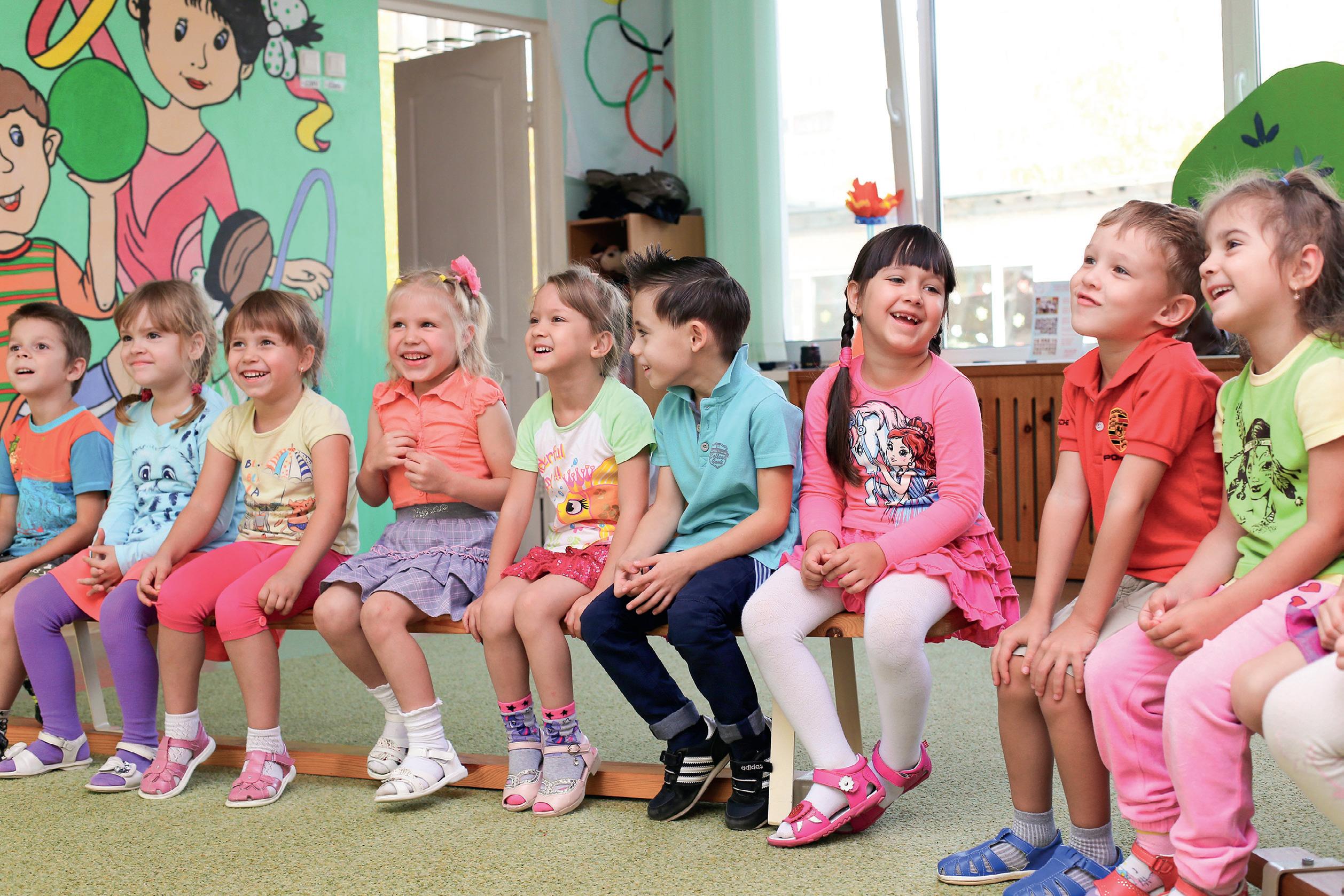
Implications of changes to early years entitlement
Exploring the impact on the property market of the Government’s extension to early years care
As the Government announces the launch of the first phase of the biggest-ever expansion in early years childcare, there are continuing concerns over the ability of nurseries to expand their buildings to accommodate tens of thousands of additional children.
From April 1 working parents of two year olds have been able to access 15 hours a week of government-funded childcare — freeing thousands of couples from having to choose between having a family and a career, as over 150,000 children are on track to secure government-funded places.
And, by September 2025, the full rollout will be completed, with working parents able to access 30 hours from the end of maternity leave to when their child starts school, saving parents an average of £6,900 a year.
But the move has led to concerns over staffing levels and the ability of the nursery estate to expand in order to meet the anticipated demand the measures will bring.
This is despite a £100m government capital funding pot, announced in October last year, to support an increase in physical space for early years and wraparound care.
STAFFING LEVELS
Neil Leith, chief executive of the Early Years Alliance, said, while welcome, the cash would not help nurseries unless underpinned by a robust workforce plan, adding: “The fact is that all the physical
space in the world won’t achieve anything if we don’t have sufficient early years staff to deliver places and meet increased demand from families.
“It is vital that the Government ensures we have the infrastructure in place to deliver the places it has promised to families — but while supporting providers to increase physical capacity is a part of this, it is only a small part.
“As such, we continue to urge the
The fact is that all the physical space in the world won’t achieve anything if we don’t have sufficient early years staff to deliver places and meet increased demand from families
14 | JUNE-JULY 2024 EDUCATION-PROPERTY.COM Finance and Property
The expansion of early years childcare is expected to increase the demand for nursery places, leading to a need for additional space
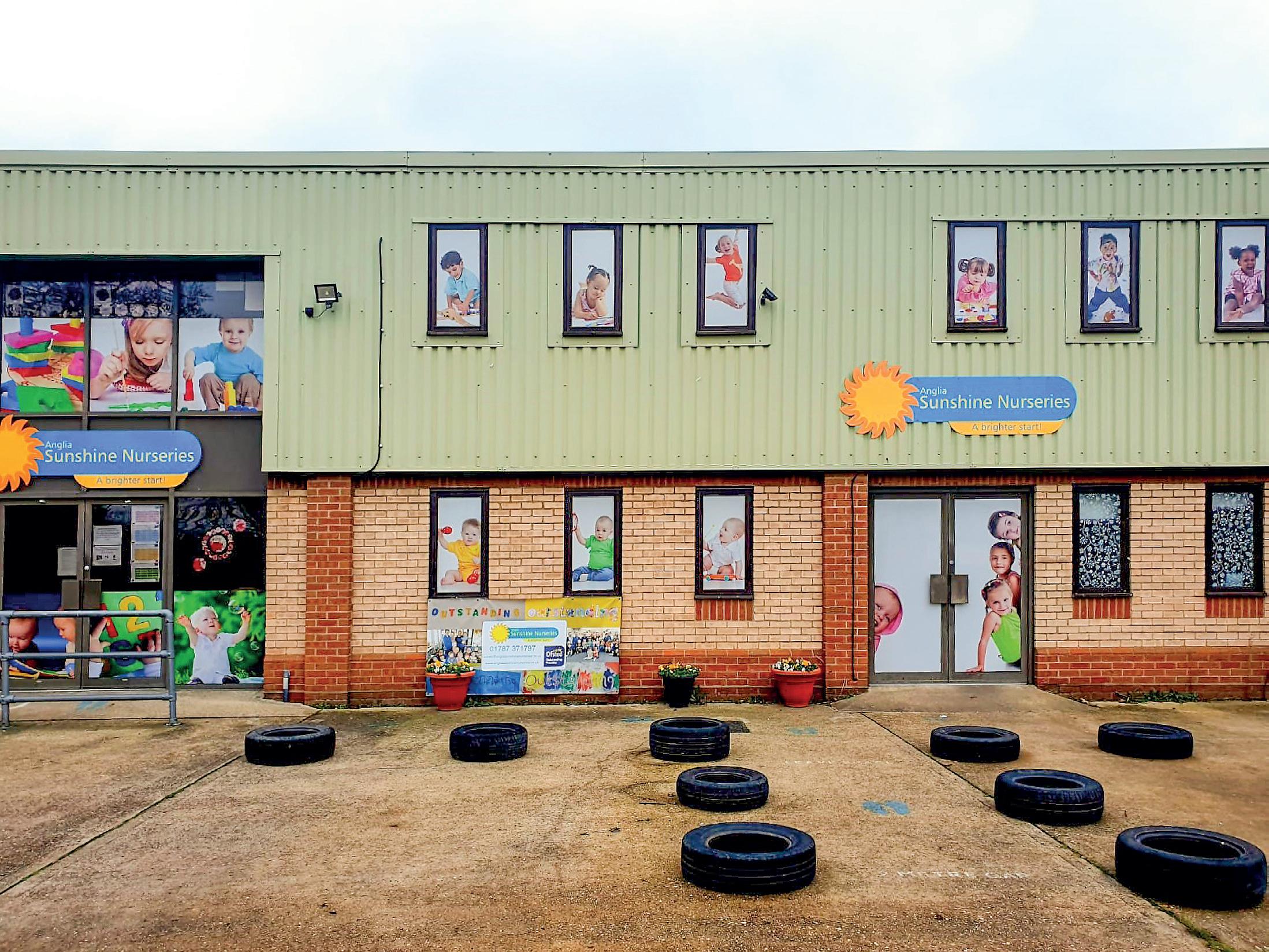
Government to focus its efforts on building and sustaining a strong, stable early years workforce by ensuring fair rates of pay through adequate funding rates, professional respect and recognition, and clear career progression. Anything less, and parents around the country looking forward to accessing the extended early entitlement offer next year are likely to be left sorely disappointed.”
In response to comments on staffing, the Government said it was launching a major national recruitment campaign, and providing over £400m of additional investment to uplift funding rates in 2024-2025.
On top of this, the Government will increase rates over the next two years by an estimated £500m, the Chancellor confirmed at the Spring Budget.
WATCH AND WAIT
The new rules are also impacting on the real estate market, with increased interest among investors and nursery operators in acquiring both single assets and larger nursery property portfolios.
Bright Horizons has been adding to its portfolio over the past year, including renovating a former office building in Shepherd’s Bush, London, into a new nursery and pre-school; and repurposing a care home to provide a new early years setting in Enfield. And Kids Planet has grown its portfolio to 191 settings across the UK since 2008 and said is it ‘continuing to look to acquire new nurseries while seeking development opportunities’.
During 2023, Christie & Co brought 236 day nurseries to the market and over the coming months it expects operators and investors will be assessing the implications of the recent changes before deciding whether to expand their property portfolios.
Nick Brown, director and head of brokerage for childcare and education at Christie & Co, told Education Property
“The anecdotal feedback we have been receiving is that a lot of operators have been waiting to see how the initial rollout unfolds on the funding front, while also waiting to see what impact the expansion may have on demand from parents for September places, ahead of making any huge investments into expansion.

“It’s early days with regards to the
but while the initial signs are positive, and anecdotally we are hearing from providers that new enquiries and registrations are increasing, there are some challenges that must be overcome if the expansion is to be a success.
…while access to capital funding to facilitate such expansion will be at the forefront of the mind, so too will the need to attract and recruit appropriate, qualified, experienced staff to be able to operate
EDUCATION-PROPERTY.COM JUNE-JULY 2024 | 15
Nick Brown
Nursery group, Storal, is among operators increasing their property portfolio in the sector with the recent purchase of Anglia Sunshine Nurseries in Suffolk, taking it to 32 registered settings across England. Image: Christie & Co

workforce challenges and should providers seek to increase capacity, be that through the conversion of existing ancillary space, expansion into new premises, or the new build development of facilities; while access to capital funding to facilitate such expansion will be at the forefront of the mind, so too will the need to attract and recruit appropriate, qualified, experienced staff to be able to operate.”
He added: “Outside of the extended entitlement announcement, many early years providers are on the lookout for new business development opportunities including expanding into new geographic locations, and opportunities that are also closer to home whereby they can create new provisions via purpose-built and purposedesigned settings which award educational and operational advantages.”
Types of properties being sought differ across the country, but operators are generally looking for properties with space for 60-plus children in buildings with a floorspace of around 3,000-4,000sq ft, according to Brown.
what may, at first, seem not to be the best building for a nursery, an amazing setting which becomes very popular, especially in areas where property and space are at a premium.
DO YOUR HOMEWORK
“The change in planning class also has the potential to ease issues around what was formerly properties needing D1 planning, so buyers have been able to look at alternative properties in the E class where previously this was much more difficult.”
When looking for vacant properties to facilitate expansion, he advises contacting general commercial property agents active in the local area.
“Speak with and register an interest with agents who have teams that specialise in the day nursery sector,” he adds.
“Get close to the brokers most active in the sector and form a relationship with them. Most will be seeing opportunities across the country every week and if you are
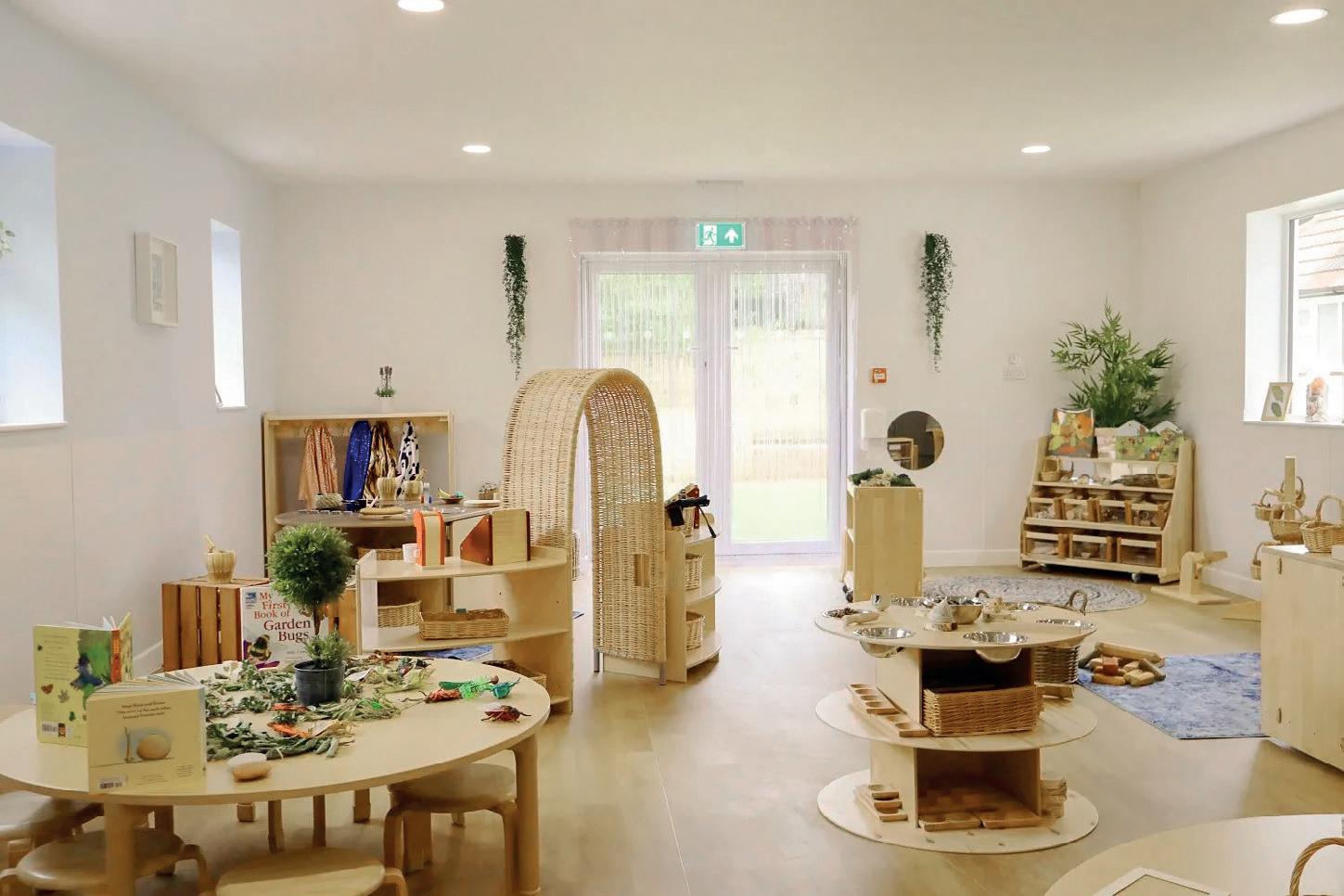
…experienced operators can come up with ideas on how to make what may, at first, seem not to be the best building for a nursery, an amazing setting which becomes very popular, especially in areas where property and space are at a premium
Other options include:
• Set up a search criteria with Rightmove commercial
• Contact the local authority commercial property and estate management departments. They may have suitable properties they are looking to lease/sell
• Register with commercial property auctioneers (for freeholds)
• Speak with local developers, especially housing and commercial developers, as they may have section 106 requirements for day nursery development as a condition of their wider planning/ development consents
• Be eagle-eyed when travelling through the area you are looking in and be open to looking at properties that offer potential, but may need planning consent for a change of use
Brown said: “Like with anything, the best opportunities won’t hang around for long.
“When seeking to raise finance for expansion, creating a robust and comprehensive business plan should enable banks to appraise commercial mortgage applications, but be mindful that operators could be bidding against cash buyers so a compelling case for them to choose you as their preferred party along with speedy access to finance will be key.”
16 | JUNE-JULY 2024 EDUCATION-PROPERTY.COM
n
The recent sale of Marlow Day Nursery in Buckinghamshire attracted interest from existing operators, first-time buyers, and those looking to re-enter the sector. Image: GoogleEarth
Bright Horizons repurposed a former care home to provide a new nursery in Enfield
MISSED AN ISSUE?
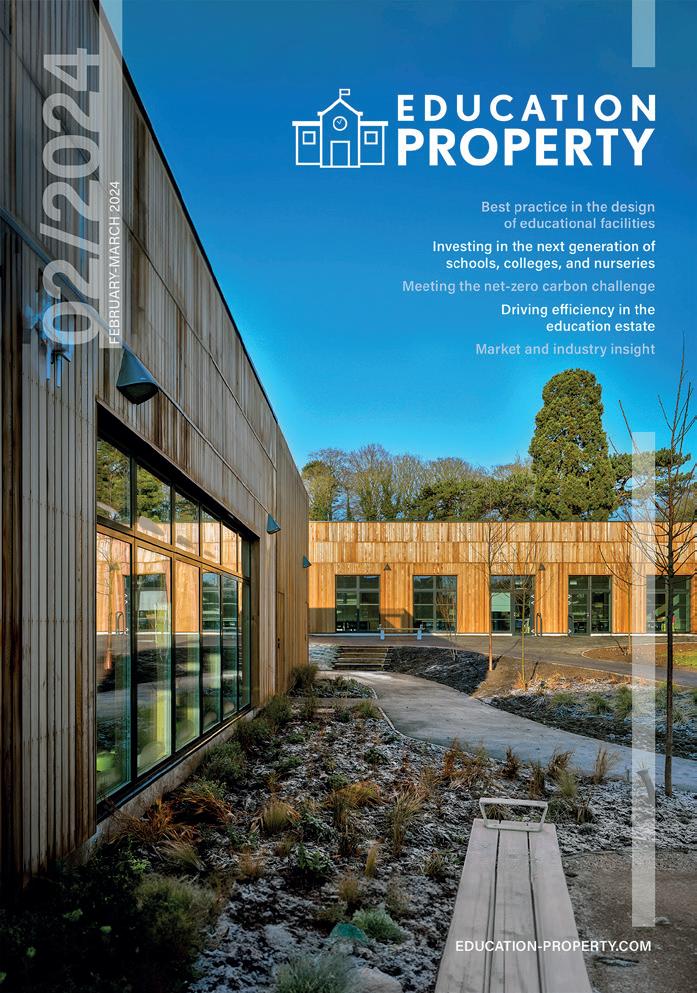
Inside issue 01, February-March 2024
• Best practice in the design of educational facilities
• Investing in the next generation of schools, colleges, and nurseries
• Meeting the net-zero carbon challenge
• Driving efficiency in the education estate
• Market and industry insight
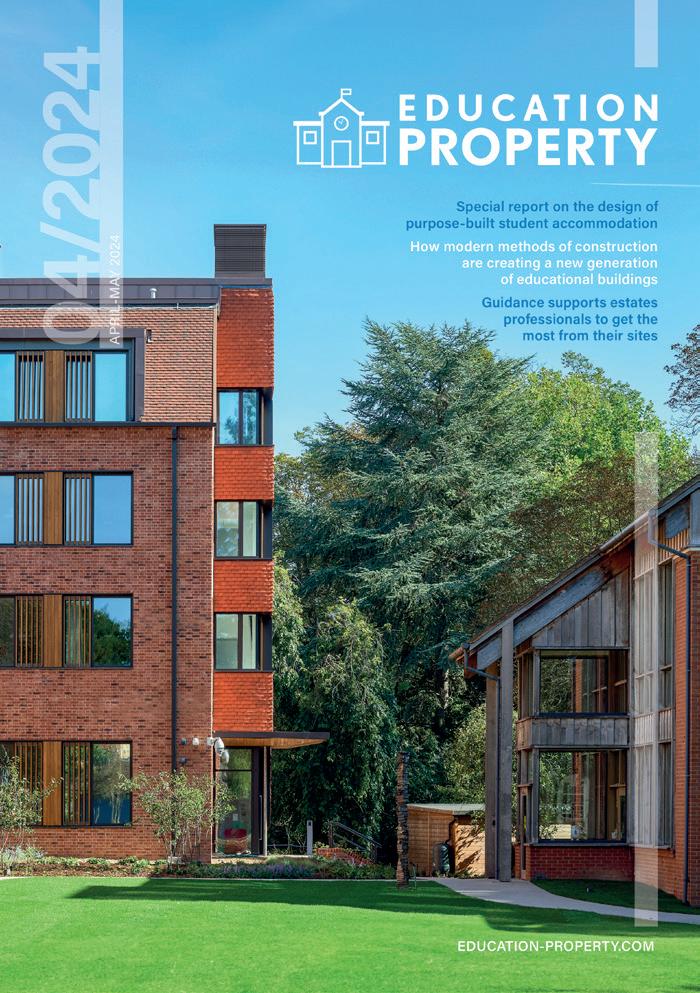
Inside issue 02, April-May 2024
• Special report on the design of purposebuilt student accommodation
• How modern methods of construction are creating a new generation of educational buildings
• Guidance supports estates professionals to get the most from their sites

EDUCATION-PROPERTY.COM Back issues available online! Scan to read now Scan to read now
Schools could lose £1bn in funding by 2030

Real-terms increases in per pupil funding over the remainder of the decade could still result in cuts to school budgets, due to significant falls in pupil numbers, reveals the Education Policy Institute (EPI).
Under a scenario where per pupil funding is increased by 0.5% in real terms each year, total school funding would fall by £1bn between 2024-25 to 2029-30, a new EPI funding model has predicted.
London and the North East are projected to experience the largest falls in funding, across both primary and secondary phases.
And primary schools are set to be the hardest hit, with total funding projected to fall by 5.6% between 2023-24 and 2029-30.
Over the same time period, total funding for secondary schools will increase until 202627, before it also begins to fall.
THE IMPACT OF POLICY
The analysis has revealed the significant impact that projected falls in pupil numbers could have on school funding across England, showing the challenges that these demographic changes will present to the financial health of educational establishments.
The report is the first to use EPI’s new school funding model, which replicates the Department for Education’s own national funding formula

(NFF) and allows researchers to analyse the impact of potential funding policy decisions on individual schools and areas of the country.
Using this model, researchers project that overall funding for primary and secondary maintained schools will fall to £41.6bn by 2029/30, down from a peak of £42.7bn in 2024/25, even if pupil-led perpupil funding is increased in real terms.
And, as the overall schools budget for all of the projection period is not yet known, the EPI uses a central estimate of a 0.5% real terms increase in pupil-led per-pupil funding, per year.
With the projected changes to pupil numbers varying throughout the country, the report also examines how school funding will be impacted across different geographic areas.

PLACE PLANNING
Falling pupil rolls are one of the key challenges facing any Government over the next decade.
And, with over half of all schools now academies, local authorities are in a difficult position of being responsible for place planning, but unable to direct academies to adjust their admissions numbers, says the report.
Key findings show that total pupil numbers in state-funded primary and secondary schools are projected to fall from a peak of 7.57 million in 2022-23, and then decrease at an average rate of 1% each year until they reach 7.14 million in 2028-29.
This means that even under a scenario where per-pupil funding is increased by 0.5% per year, overall funding would still fall by £1bn by 2029-2030.
Total funding would peak in 2024-25 at £42.7bn, but would then decrease by a yearly average of 0.5% until 2029-30, where it would fall to £41.6bn — 2.6% lower than its peak in 2024-25.
And primary funding will be overtaken by secondary funding in 2026-27.
A DOWNWARD TREND
In 2023-24, total funding for primary schools was 5.9% higher than total funding for secondary schools.
The report reveals that primary funding will decrease until it is overtaken by secondary funding in 2026-27, when both funding totals begin
18 | JUNE-JULY 2024 EDUCATION-PROPERTY.COM Finance and Property
new report from the Education Policy Institute reveals that schools in England face a number of challenges when it comes to funding ‘ ’ move funding allocations towards a ‘hard’ ‘ ’
A
OF THE SCHOOLS BLOCK OF THE NATIONAL FUNDING FORMULA, 2023-24 –TOTAL NUMBER OF PUPILS IN MAINSTREAM SCHOOLS, SECONDARY, 2022/23 — 2028/29
Source: The national funding formulae for schools and high needs, 2023-24. DfE, July 2022
STRUCTURE
PERCENTAGE CHANGE IN PUPIL NUMBERS AT REGIONAL LEVEL, PRIMARY AND SECONDARY, 2022/23 — 2028/29
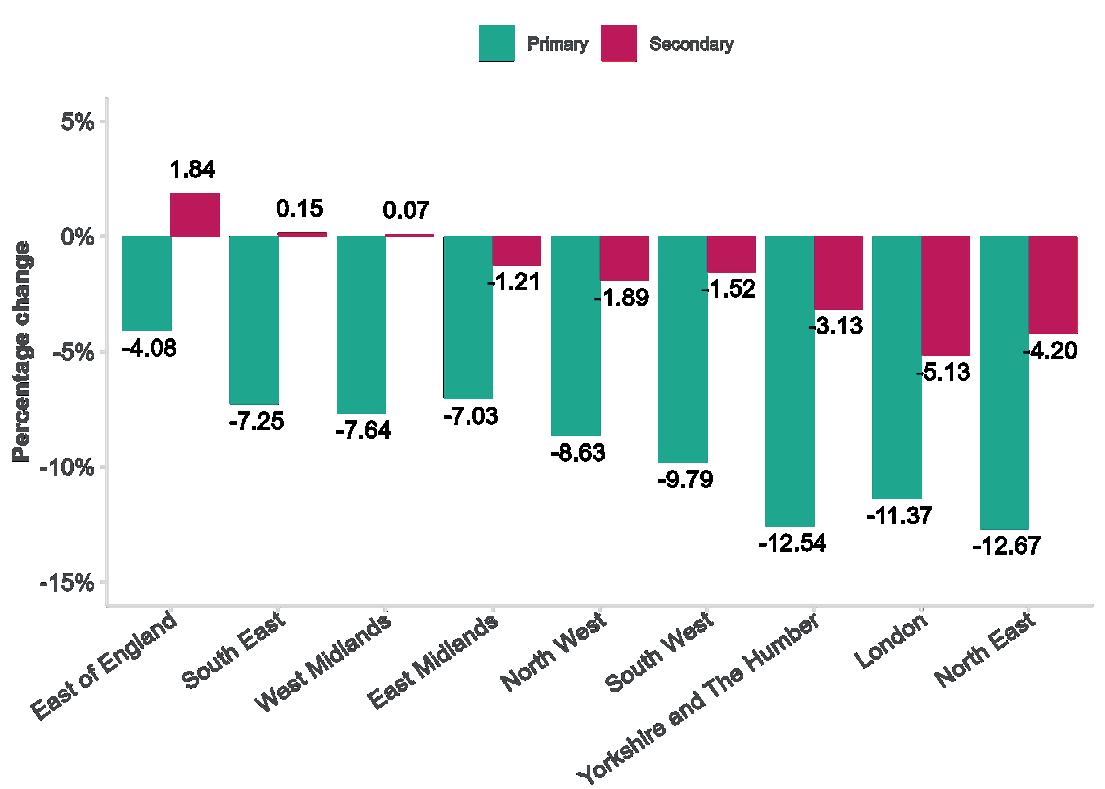
a downward trend.
By 2029-30, secondary funding will be 1.2% higher than primary funding.
All regions will experience a decrease in primary school funding between 2023-24 and 2029-30, with the North East projected the largest decrease of 9%.
The East of England is projected the smallest decrease, with just a 1.2% drop in funding
In secondary schools, all regions with the exceptions of Yorkshire and the Humber, the North East, and London are projected to experience an increase in funding between 2023-24 and 2029-30.
The East of England is projected the largest increase at 4.9%
For local authorities, Lambeth is projected the largest decrease in funding, with 21.2% at primary and 15.7% at secondary.
REGIONAL OUTLOOK
The largest increase in funding between 2023-24 and 2029-30 is projected to occur in Central Bedfordshire with a rise of 13.1% primary and 17.8% at secondary.
If changes in pupil numbers in parliamentary constituencies are consistent with those in their constituent local authorities, the largest drop in funding is projected in Streatham, decreasing by 21.3% at primary and 15.8% at
secondary.
South West Bedfordshire is projected the largest increase, 13.4% at primary and 17.8% at secondary
And the report states that if decreases in funding due to falling pupil numbers were ‘reinvested’ and funding was maintained at peak levels of 2024-25, funding could be increased by a further £148 for primary pupils, and £164 for secondary pupils by 2030.
In future work, EPI plans to investigate how funding could be weighted more heavily towards schools with greater numbers of disadvantaged pupils, to help tackle the widening attainments gaps that these pupils face.
SCALE OF CHANGE
Robbie Cruikshanks, researcher at the EPI, said: “The scale of change projected in the pupil population presents major policy challenges to future governments.
“Most school funding is allocated on a per-pupil
TOTAL FUNDING FOR MAINSTREAM SCHOOLS, PRIMARY AND SECONDARY, 2023-24 — 2029-30

PERCENTAGE CHANGE IN TOTAL FUNDING AT REGIONAL LEVEL, PRIMARY AND SECONDARY, 2023-24 — 2029-30
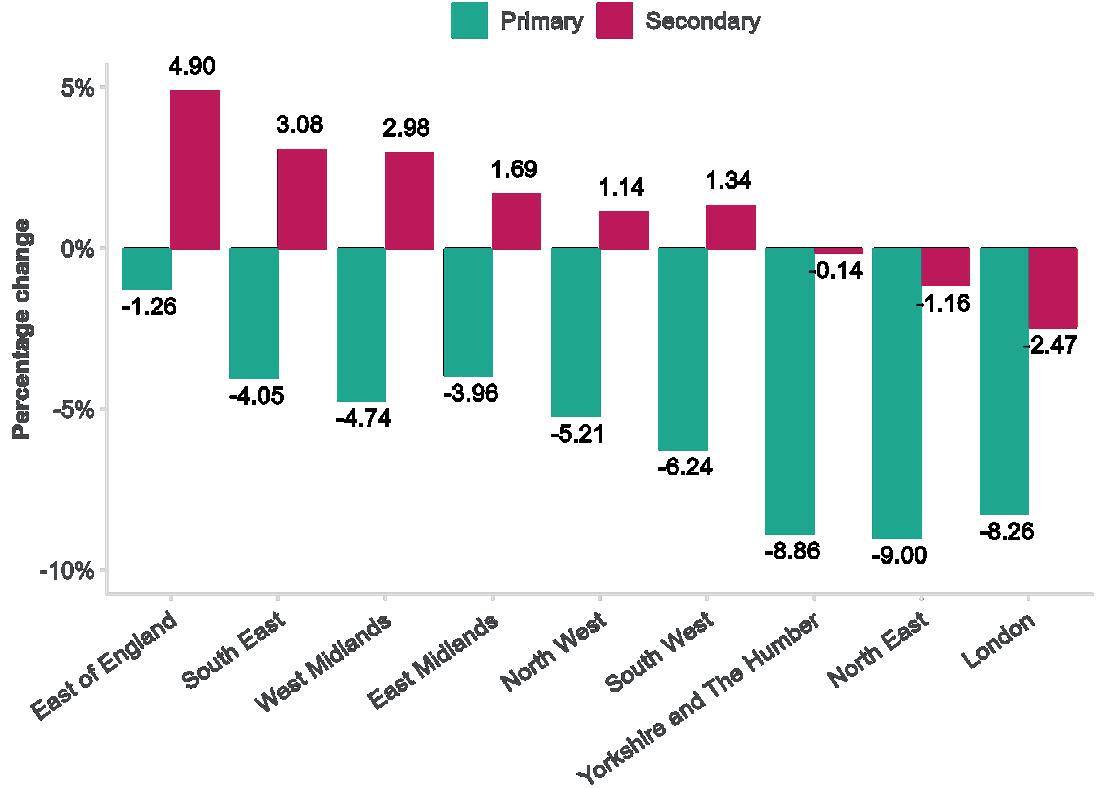
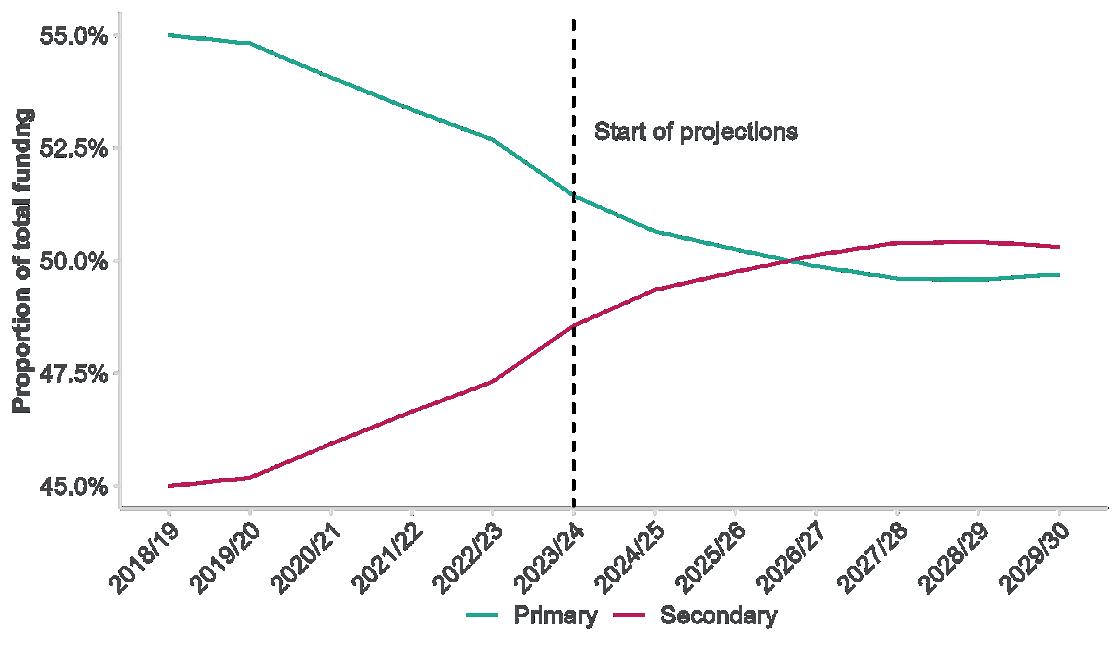
basis. As a result, falling pupil numbers can mean lower budgets for schools while not lowering costs in the same way, given these are largely fixed.
“Managing this fall in pupil numbers means that, in many areas of the country, the number of pupils that are admitted to schools will inevitably fall. This could then lead to mergers to ensure that schools remain financially viable, or even school closures.
“One of the key challenges
facing the system is that pupil place planning remains the responsibility of local authorities, but ultimately they have no statutory levers to direct academies to adjust admissions numbers.
“Policymakers must carefully consider the impacts of changes to the national funding formula on schools that are most affected by falling pupil numbers and how best to redistribute any savings created by these falls.” n
Policymakers must carefully consider the impacts of changes to the national funding formula on schools that are most affected by falling pupil numbers and how best to redistribute any savings created by these falls
Finance and Property EDUCATION-PROPERTY.COM JUNE-JULY 2024 | 19
–‘ ’ ––

Early years — the ‘forgotten sector’
A new petition is lobbying the Government to abolish business rates for early years providers
AParliamentary petition has been launched to push for early years providers in England to be exempt from paying ‘unfair’ business rates.
Debbie Moliterno, owner of Cheeky Monkeys Two Day Nursery in Bedford and co-owner of Cheeky Monkeys Day Nursery in Borehamwood, has launched the action, which is supported by the National Day Nurseries Association (NDNA) and Federation of Small Businesses (FSB). It comes as research by the NDNA reports that the average nursery in England pays £21,034 per year in business rates.
For many, bills are much higher, especially in London and other large cities. And the revaluation exercise in 2022 increased bills by an average of 40% for nurseries.
Early years providers in Wales and Scotland have been exempt from paying business rates for a number of years because their governments acknowledge the social good that they do, their financial pressures, and the government-funded places they deliver.
CHANGING TIMES
Jonathan Broadbery, director of policy and communications at the NDNA, told Education Property the policy was a throwback to the time when nurseries were run more like private businesses and before government-funded childcare.
He said: “We are moving towards a time
when up to 80% of early years hours are government funding.
“It is not fair to keep rating them as purely-private businesses because they are so integral to delivering these extra hours and so closely regulated by the Government — on everything from the amount of outdoor space to floor space.
If the Government is serious about supporting parents with their childcare bills, they need to remove this tax and support the early years sector so they can get on with the job of educating our youngest children and helping them reach their full potential
20 | JUNE-JULY 2024 EDUCATION-PROPERTY.COM Finance and Property
Image: Alicja from Pixabay
“Something has to give because when you look at schools and academies, they are subject to business rates, but the Government pays these directly. They get a bill and the Government pays it for them.
“We need to either move to a point where it is the same for early years providers, but that takes a lot of admin, so it is much easier to do what they do in Scotland and Wales and say this particular type of building is exempt.
“They did it in COVID and they can do it again now with a stroke of a pen.”
MEETING DEMAND
NDNA chief executive, Purnima Tanuku OBE, added: “With the Governmentfunded childcare expansion ongoing, early education and care providers are working extremely hard to meet local demand.
“The Institute for Fiscal Studies estimates that the Government will soon be paying for 80% of hours in nurseries. However, providers’ budgets are stretched, and they are making an average loss on places for three and four year olds of £2.36 per hour per child.
“Exempting them from paying business rates — which school settings do not have to pay — would really help towards their overall sustainability.
“We need a thriving early years sector to fulfil the Government’s ambitious expansion plans, not a shrinking one.
“If the Government is serious about supporting parents with their childcare bills, they need to remove this tax and support the early years sector so they can get on with the job of educating our youngest children and helping them reach their full potential.”
Moliterno told Education Property: “As providers of early education and care, we want to do the absolute best for our children, but we are trying to meet legislative requirements while being underfunded and having to pay business rates.
“If we all stick together then we will be

able to make a difference and help stop more quality nurseries from being forced to close down.
“We are simply the forgotten sector.”
SUPPORTING PROVIDERS
And Tina McKenzie, policy chair at the Federation of Small Businesses (FSB), said: “Small childcare providers are having to deal with a barrage of ever-increasing operating costs, with utilities, employment costs, rent, and business rates bills all stacking up.
“At the same time these nurseries and pre-schools must meet strict requirements to ensure staffing levels and have up-to-date training, all while working hard to keep up with the current increasing demand for childcare places and providing quality care.
Taking business rates bills out of the equation with a 100% rates relief scheme in England — matching the crucial support given to nurseries in Scotland and Wales, which are facing the same issues — would make a huge difference to small childcare businesses across the country
“Taking business rates bills out of the equation with a 100% rates relief scheme in England — matching the crucial support given to nurseries in Scotland and Wales, which are facing the same issues — would make a huge difference to small childcare businesses across the country.”
During the COVID-19 pandemic in 2020-21, nurseries in England were given 100% rates relief, followed by a 66% reduction the following year due to the essential nature of their business.
And an NDNA survey discovered that if they did not have to pay business rates, 61% of nurseries would be able to pay their staff more; 50% would reduce business losses, and 41% would reduce their fee increases to parents.
THE NEXT STEPS
The Parliamentary petition will run for six months and, if it attracts 10,000 signatures, the Government will be required to review it and respond.
If it exceeds 100,000 signatories, it will be eligible for a formal debate in Parliament.
Broadbery said: “We currently have around 3,000 signatures and with an election coming up, we need to show there is a strength of feeling and demonstrate that it is not just childcare providers who want this, but parents too.
“Providers tell us that if they weren’t paying rates, they could pass on these savings to litigate some of the fee increases parents are facing.” n
Finance and Property EDUCATION-PROPERTY.COM JUNE-JULY 2024 | 21

Estates implications of changes to VAT and endowment fees
This article looks at the impact on the estate of Labour’s proposals to change the rules around permanent endowment fees and VAT charges on private school income
The Labour Party’s controversial plans to charge VAT on private school fees if it wins the next general election will put pressure on estates managers to use their assets more efficiently, according to Molly Skinner, an associate at property consultancy, Fisher German.

The party’s manifesto outlines its intention to remove the current VAT exception for education provided by private schools in
an effort to raise tax revenue and improve standards in state schools.
But, while many schools warn this could lead to closures, Skinner believes the threat could be countered if they make better use of their estates.
She said: “The party’s announcement to charge 20% VAT on private school fees and clamp down on any possible avoidance by parents leaves schools with a stark choice.
“Schools could choose to absorb the cost, heavily impacting their cash flow; pass the costs onto parents, inevitably reducing pupil numbers; or reduce the number of bursary and scholarship places, which reduces opportunities for less-well-off children.
“None of these options are ideal, and most private schools will have to make some very difficult decisions should Labour be elected and follow through on its pledge.
UTILISING ASSETS
“But, in my experience working with the education sector at Fisher German, schools don’t always utilise their property assets to generate the most income and save money, and some are paying far too much for certain outgoings.”
She adds: “In terms of best utilising assets, many schools do not realise just how valuable their property can be.
“As part of an asset review, we undertook for Moulton College in Northamptonshire,
EDUCATION-PROPERTY.COM Finance and Property
Molly Skinner
we identified four buildings on the edge of the campus, no longer suitable for educational purposes, which we have since let.
“This has, in turn, generated additional income to be invested back into the college.
“Other ways schools may be overspending is by using old-fashioned methods of powering their buildings.
CARBON REDUCTION
“We have recommended certain schools install discreet solar panels to save on electricity bills, and to generate an extra source of income with carbon credits.
“The installation of other infrastructure such as telecom masts in a quieter area of the school’s property is another way of bolstering income.”
She advises speaking to consultants to identify opportunities for savings and improved utilisation of buildings.
“Many decision-makers may not know where to start when it comes to identifying these opportunities on top of running a busy school, but this is where having external experts come in can help,” she said.

CHANGING THE RULES
“We are already helping many education clients save money and find new streams of income, and with Labour’s announcement in mind, it is more important than ever that private schools make the best use of what they have.”
CHARITABLE STATUS
Also potentially problematic for independent schools will be proposals to remove the 80% business rates reduction many independent schools currently benefit from through their charitable status and potentially removing charitable status from private educational establishments altogether.
Rachel Spruce, an associate at Penningtons Law, said: “Charitable status is a legal construct, conferring tax benefits in return for benefits widely believed to be for the public good.
“This does not mean that every organisation with charitable aims or activities can legally be registered as a charity. However, it does (or is intended to) mean that every registered charity is a charitable organisation that meets a certain threshold of public benefit.
“At their foundation, many fee-paying schools were institutions set up to provide education to those who would otherwise be denied it, often those deemed to be ‘poor’ or ‘impoverished’.
“Fast forward to today and those roots can seem far away, especially when school fees can be upward of £30,000 per year, even for those who do not board.
“Going back, however, to the foundations of such fee-paying schools, their land, assets, and financial backing can take the form of ‘permanent endowment’; that is to say, capital in the form of property, cash or other assets that are either functional, and can be used by the charity (in the case of land and other tangible assets), or invested (usually cash, securities etc, although sometimes land that is rented out) to provide an income.
“Some of the rules surrounding permanent endowment assets have changed under the Charities Act 2022. However, the basic premise remains the same: significant permanent endowment can only be sold, or otherwise parted from, with the permission of the Charity Commission.
“It is intended to permanently form part of the assets of the charity to which it was given.
“Weakening the safeguards around permanent endowment assets risks alienating donors, and even possibly the reputation of the charitable sector as a whole.
“The changes brought in by the Charities Act 2022 are starting to ripple through into the transactional work of charities, such as where now-obsolete land may need to be sold, or where investments are sold or used as security for a loan.
“However, the removal of charitable status for a whole swathe of the sector would remove the permanent endowment safeguards entirely for those organisations.”
STALLING REFORM
In the case of fee-paying schools, she said it was common for the physical buildings and land used by the school to be permanent
endowment.
“Some may be held by the schools themselves, others through related charitable trusts,” she adds.
“Over the years, the uses of the land may have changed, with parts redeveloped, sold off, or compulsorily purchased in support of maintaining the financial security of the registered charity school in question. This will all (hopefully) have been carried out in accordance with the regulatory requirements of the time.
“The specific origins of how these permanent endowment assets came to be the property of the charity can be complex, many dating back to original grants of land that are decades, if not hundreds of years, old.
“Unravelling all of that, for example to allow the sale of a specific parcel of land, such as one now cut off from the school’s main centre of activities, can be quite the undertaking, even when only dealing with one specific organisation.
“Attempting to legislate to cover all such potential eventualities would be incredibly complex and time consuming. It is a legal maze that could tie things up for years, creating delay and even potentially preventing any reform at all.
“The rationale for the Labour Party confining its proposed changes to these specific tax benefits perhaps finds its roots in (among other things) the complexities of permanent endowment.
“Removing charitable status altogether would cause tremendous difficulties in dealing with permanent endowment, as well as other issues, stalling or even frustrating potential reform entirely.” n
Finance and Property EDUCATION-PROPERTY.COM JUNE-JULY 2024 | 23
Image: AI-generated (Adobe Firefly)
Nurturing the next generation
Nurture Me Day Nursery in Lutterworth, Leicestershire, has been sold to Kids Planet Day Nurseries, which has more than 190 early years facilities across the UK.
The nursery was launched in 2012 by Gill Masters and Helen Smith, who have announced their plans to retire.
The Ofsted ‘Good’-rated business caters for 106 children, as well as operating an out-of-school and holiday club for 25 youngsters.
It was purchased by Kids Planet Day Nurseries following a confidential sales process led by David Eaves at Christie & Co.
Clare Roberts, chief executive at Kids Planet Day Nurseries, said: “The nursery fits well into the Kids Planet family, coming with a wellestablished leadership team and a highly-qualified workforce.”
Eaves added: “Using our sector experience and deep market knowledge we were able to secure multiple offers in a short space of time and achieve a completion only six weeks from agreeing terms.
“We continue to see an exceptional level of demand for high-

capacity for up to 78 children.
It occupies a purpose-built property that combines a homely atmosphere with the feeling of space and light.
And its large and colourful playrooms have a modern feel with the children being cared for in peer groups with easy access to the outside play area.
The setting has been owned by Vicky Hallas-Fawcett since 2016 and was brought to market to allow her to downsize her operations and concentrate on the three other settings in the group.
Following a confidential sales process with Vicky Marsland at Christie & Co, and with funding sourced through David Quigg at Christie Finance, it has been purchased by Jill Dyson and Carly Cowling, both of whom have backgrounds in primary education.
The new owners said: “Working in education allowed us to visit nursery settings and it was often easy to understand why children were not school ready.
“We wanted to make a real difference within our local community, to give the children the best-possible start to education.
“On viewing the property, we could see the potential to create our vision as it had vast outdoor space in which we can create an all-weather outdoor provision.
“Going forwards, we plan to heavily market the setting as it is currently unknown in the local area.”

creates an excellent opportunity for nursery owners to maximise the value they can achieve in a sale process.”
Former prep school comes to market
Global property consultancy, Knight Frank, has been instructed by the trustees of the former Ursuline Preparatory School in Wimbledon to sell the school property, with a guide price of offers in excess of £7m.
The freehold property is offered with vacant possession and presents an incredibly-rare opportunity for buyers, either as a turnkey educational facility or with regard to its potential for alternative uses or development, subject to obtaining necessary consents.

Last operated as a predominantly all-girls preparatory school and nursery that has had a presence in Wimbledon since around 1892, the property features an attractive Victorian villa as a focal point, along with several other buildings including St Angela’s, a modern facility which was constructed in 2015 to house the early years and school’s offices.
Outside there is a multi-use games area and gardens.
The property extends to approximately 21,609sq ft of accommodation across the 1.139-acre site — all situated in one of south west London’s most-desirable residential areas.
“The sale of the Ursuline Preparatory School on The Downs in Wimbledon presents a rare opportunity for an owner operator or investor in the educational sector to acquire this unique asset. Equally, it will undoubtedly appeal to other end users or developers given its scale and location in one of London’s most-sought-after postcodes”, said Emma Cleugh, head of education and charities at Knight Frank.
Situated in a Conservation area on The Downs, roughly mid-way between The Ridgway and Worple Road, the property is around a 15-minute walk from Wimbledon Village and the leafy green spaces of Wimbledon Common and further benefits from excellent transport links at Wimbledon station, as well as major road routes, including the A3 and A24, which are both less than a mile away.
24 | JUNE-JULY 2024 EDUCATION-PROPERTY.COM Finance and Property Deals























Coming together!
Exploring plans for a new Health Innovation Hub in Glasgow, which will forge partnerships between academia, industry, clinicians, and the community in order to better tackle healthcare challenges
Academia and specialist commercial leaders are coming together as work gets underway on a flagship new Health Innovation Hub in Glasgow, due for completion in autumn 2025.
Kadans Science Partner has recently started construction work on the precision medicine facility in Govan, in partnership with the University of Glasgow, and supported by Scottish Enterprise.
It follows recent research from Savills which revealed a huge amount of investment in the life science sector, with £5.6bn of venture capital being ploughed into life science-related companies headquartered in the UK — a 120% increase between 2020-2021 and 500% since 2017.
Key cities across the UK, and the rest of the world, are seeing emerging clusters of activity, and it is hoped that such a focus on life sciences in Glasgow will bring huge rewards for wider prosperity and education.
With research links to the Queen Elizabeth University Hospital, the new Health Innovation Hub, designed by Hawkins\Brown, will set the stage for a thriving life sciences cluster in the area.
It will offer laboratory and office accommodation, attract new and innovative businesses to the area, and deliver local benefits to the wider community.
The flexible nature of the design also means tenants can grow and evolve within the building over time, making the Health Innovation Hub their long-term home.
The project is targeting a BREEAM ‘Excellent’ sustainability rating.
Speaking to Education Property, James Dawson, development manager at Kadans Science Partner, said: “Developments of this kind ar e increasingly being delivered to drive collaboration between hospitals and world-leading universities to better tackle global healthcare challenges.
“Traditionally located around centres of excellence; they provide environments where university spin-out businesses can grow and innovate with close collaborations with hospitals offering new advanced treatments.”
The state-of-the-art building, which is being built by Morrison Construction, has been designed to create opportunities for collaboration between commercial

Dawson said: “Kadans supports the growth of businesses through flexible design and commercials along with soft support such as our ecosystem services.”
Lead architect, Shirley Wong, of Hawkins\Brown, adds: “The groundfloor space will include a Digital Health Validation Laboratory, operated by the university, which will support the testing and development of new technologies, such as contactless stethoscopes.
“This space will enable clinicians to work with participants to trial new medical technologies and drive improvements in clinical interventions and treatments.
“On the upper levels of the building there
laboratories. These have been designed to be flexible so that companies can tailor them to their specific needs.
And Dawson said: “Collaboration and flexibility has remained at the heart of the design, providing space that fosters innovation and community among the clinician and academic occupiers.”
Externally, the building will have a rustred façade, representing the area’s heavily industrial past — while windows are spaced at varying intervals, inspired by the DNA Helix.
To reduce energy use, there will be 300sq m of solar panels fitted on the roof and EV chargers will be available in the carpark. n
Collaboration and flexibility has remained at the heart of the design, providing space that fosters innovation and community among the clinician and academic occupiers
26 | JUNE-JULY 2024 EDUCATION-PROPERTY.COM Building Design
A mixed outlook for education construction
The education construction sector is helping to buck the trend across the wider industry, with a slight increase in the number of projects starting on site in the three months to the end of April.
According to the latest Construction Market Review from Glenigan, while main contract awards and detailed planning approvals declined against both against the previous quarter and the same period last year; more positively, project starts grew on the preceding three months.
the largest share of education construction starts (78%), totalled £1bn, having grown 34% on the previous year.
Universities, on the other hand, fell 53% against last year to total £131m, accounting for a 10% share of the total sector value.

Totalling £1.3bn, education work starting on site grew 2% on the three months to the end of April 2024 to stand 7% down on the previous year.
No major projects (worth £100m or more) started during the period, a decrease from the preceding quarter, but unchanged from a year ago.
CRUNCHING THE NUMBERS
But underlying education work starting on site (less than £100m in value) increased 9% against the preceding three months on a seasonally-adjusted (SA) basis and was 7% down on a year ago.
Education main contract awards decreased 2% against the preceding three months to total £1bn, with the value remaining 36% lower than the previous year.
Underlying contract awards decreased 8% against the preceding three months, but declined by 36% against the previous year.
And no major projects reached the contract awarded stage, unchanged on the preceding three months and the previous year.
Totalling £1.2bn, detailed planning approvals — an indicator of the future project pipeline — fell 10% against the preceding three months and were 12% lower than last year.
Like project starts and main contract awards, there were no major project approvals.
And underlying project approvals fell 9% against the previous three months to stand 12% down against last year.
GOOD NEWS
But there is good news for the sector as school projects starts, which accounted for
College project starts also experienced a weak period, with the value having fallen 12% against the previous year to total £108m, accounting for an 8% share of work starting on site.
Regionally, London was the most-active region for education project starts during the three months to April, accounting for an 18% share of the sector to total £231m, having increased 366% on last year’s levels.
Yorkshire & the Humber accounted for 10% of starts in the sector and grew 55% against the previous year to total £127m.
In contrast, accounting for a 15% share, Scotland decreased 10% on a year ago to total £197m; and the South East experienced an 11% drop on a year ago, totalling £132m.
REGIONAL ACTIVITY
However, the South East was the mostactive region for detailed planning approvals, accounting for a 16% share, with the value having grown 52% on a year ago to total £192m.
Yorkshire & the Humber also grew 247% in value against last year to total £154m; and the West Midlands increased 29% against last year to £135m.
Top contractors over the report period were Royal BAM with 14 projects totalling £515m; Kier with 24 projects totalling £492m; and Morgan Sindall, with 45 projects worth £449m.
The leading clients were the Department for Education, with 196 projects worth £941m; Kier, which is working on seven projects valued at £125m; and Sheffield Hallam University, with one project worth £100m.
Commenting on the findings, Glenigan’s economist, Drilon Baca, said: “The latest data shows a continuing weak start to the year, with investment deterred by uncertain economic conditions.
“Education experienced a mixed period, with the value of underlying project starts increasing 9% against the preceding three months to stand 7% down on a year ago.”
Building Design EDUCATION-PROPERTY.COM JUNE-JULY 2024 | 27
Education: Detailed Planning Approvals Education: Main Contract Awards Education: Starts Source: Glenigan Three month average Source: Glenigan Three month average Source: Glenigan Three month average Under £100M Under £100M Under £100M Over £100M Over £100M Over £100M Mar 24 May 22 Jul 22Sep 22Nov 22 Jan 23Mar 23May 23 Jul 23Sep 23Nov 23Jan 24 £million 600 500 400 300 200 100 0 Mar 24 May 22 Jul 22Sep 22Nov 22 Jan 23Mar 23May 23 Jul 23Sep 23Nov 23Jan 24 700 600 500 400 300 200 100 0 £million Mar 24 May 22 Jul 22Sep 22Nov 22 Jan 23Mar 23May 23 Jul 23Sep 23Nov 23Jan 24 £million 700 600 500 400 300 200 100 0 8% 78% 10% 4% Contractors Projects£m Royal BAM 14 515 Kier 24 492 Morgan Sindall 45 449 Willmott Dixon 18 382 Bowmer & Kirkland 17 229 ISG 13 229 Galliford Try 19 153 Tilbury Dougla 17 133 Graham Construction 10 128 Bouygues 4 111 Clients Projects£m Department for Education 196 941 Kier 7 125 Sheffield Hallam University 1 100 Bridgend College 2 90 Northumberland County Council 3 81 Fife Council 1 80 City of Edinburgh Council 5 71 Exeter College of Further Educ. 1 70 Royal BAM 5 69 Hampshire County Council 9 64 Education: League Tables (May 2023 to April 2024) Types of Education Projects Started Three Months to April 2024 Source: Glenigan Source: Glenigan Colleges Other Education Schools Universities Planning Approvals Starts 18% 10% 8% 15% 10% 10% 4% 3% 10% 3% 1% 8% STARTS PLANNING APPROVALS 7% 1% 11% 7% 6% 5% 16% 5% 11% 14% 4% 13% 1000% 800% 600% 400% 200% 0% -200% EastofEnglandEastMidlands London NorthEastNorthernIreland NorthWest SouthEast SouthWest ScotlandWestMidlands Wales Yorkshire -48% -79% -45% -11% -21% 0% -72% 55% -68% 23% -21% -69% 52% -14% -10% -37% 29% 247% -18% -20% 853% &theHumber -20% 0% 366% Share Value of Education Starts and Planning Approvals in the Last 3 Months Changes in Education Starts and Planning Approvals on a Year Earlier Source: Glenigan Source: Glenigan East of England East Midlands London North East Northern Ireland North West South East South West Scotland West Midlands Wales Yorkshire & the Humber EXECUTIVESUMMARY Offices Retail Housing Industrial May 2024 CONSTRUCTION REVIEW THE GLENIGAN CONSTRUCTION REVIEW Reflecting activity to the end of April 2024 Detailed planning approvals decreased 11% against the previous year 21% decline in project-starts against 2023 levels 16% decrease in main contract awards compared with the preceding three months

Making all the right noises
In this article, Jo Makosinski explores the key role acoustic treatments play in creating more-effective learning environments
The first thing you notice when you walk into many school buildings is the noise! Whether it’s teachers giving lessons, PE classes taking place, or just the general sound of children and staff playing, chattering, or moving around; there is no escaping that educational facilities are noisy places.
But it doesn’t have to be this way. And, increasingly, we are learning that such noise nuisance can have a very-detrimental impact on teachers’ ability to do their jobs and pupils’ and students’ ability to learn. It can also lead to sensory overload which, in turn, can cause significant issues with
learning and behaviour.
There are few places within school buildings where there isn’t considerable noise pollution, from entrance halls and corridors, to classrooms, dining halls, and external spaces such as playgrounds.
And this is where acoustic design becomes critical.
BAD MANAGEMENT
Jeremy Tuffin, head of major projects at education design and construction specialist, Envoplan, explains: “The impact of constant loud sounds in learning areas gives rise to students having difficulties with
reading, language, speech, and spelling, as well as cognitive development, leading to a lack of focus and motivation, added stress, and negative social interaction.
“If teachers are hard to hear over the general hubbub in classrooms, students will feel a lack of engagement, meaning their relationships with those trying to teach them, and also with other pupils, may significantly deteriorate.
“Studies show that schools featuring bad sound management lead to a number of disorders, including voice strain from teachers having to shout, or hearing issues for both students and teachers, as well as

28 | JUNE-JULY 2024 EDUCATION-PROPERTY.COM Building Design
Triangles and hexagons are increasingly used in acoustic treatments as they help distribute sound waves and reduce echoes


Studies show that schools featuring bad sound management lead to a number of disorders, including voice strain from teachers having to shout, or hearing issues for both students and teachers, as well as behavioural issues among pupils, often resulting in poorer classroom discipline
behavioural issues among pupils, often resulting in poorer classroom discipline.”
Especially for younger learners, hearing at an early age in the classroom means higher levels of understanding when sounding words out; and for all learners, sound absorption makes it easier to hear and understand their teachers, meaning they will retain a greater knowledge from their subject lessons.
The World Health Organization
recommends that noise should be less than 35 decibels in classrooms to allow for good teaching and learning conditions.
But one study of UK primary schools found the average to be 65dB — almost as loud as a tumble dryer.
ESTABLISHING A BASELINE
When considering classroom environments in particular, there are a number of interventions that can be designed into new-
build facilities or retrofitted into existing buildings to help mitigate noise nuisance.
For instance, thick curtains, wall-towall carpet, and soft furnishings can have an instant positive impact on noise reverberation.
But, thinking more long term, and looking more widely across all areas of a school estate, the first step should be determining where noise is coming from and how it moves round a space.

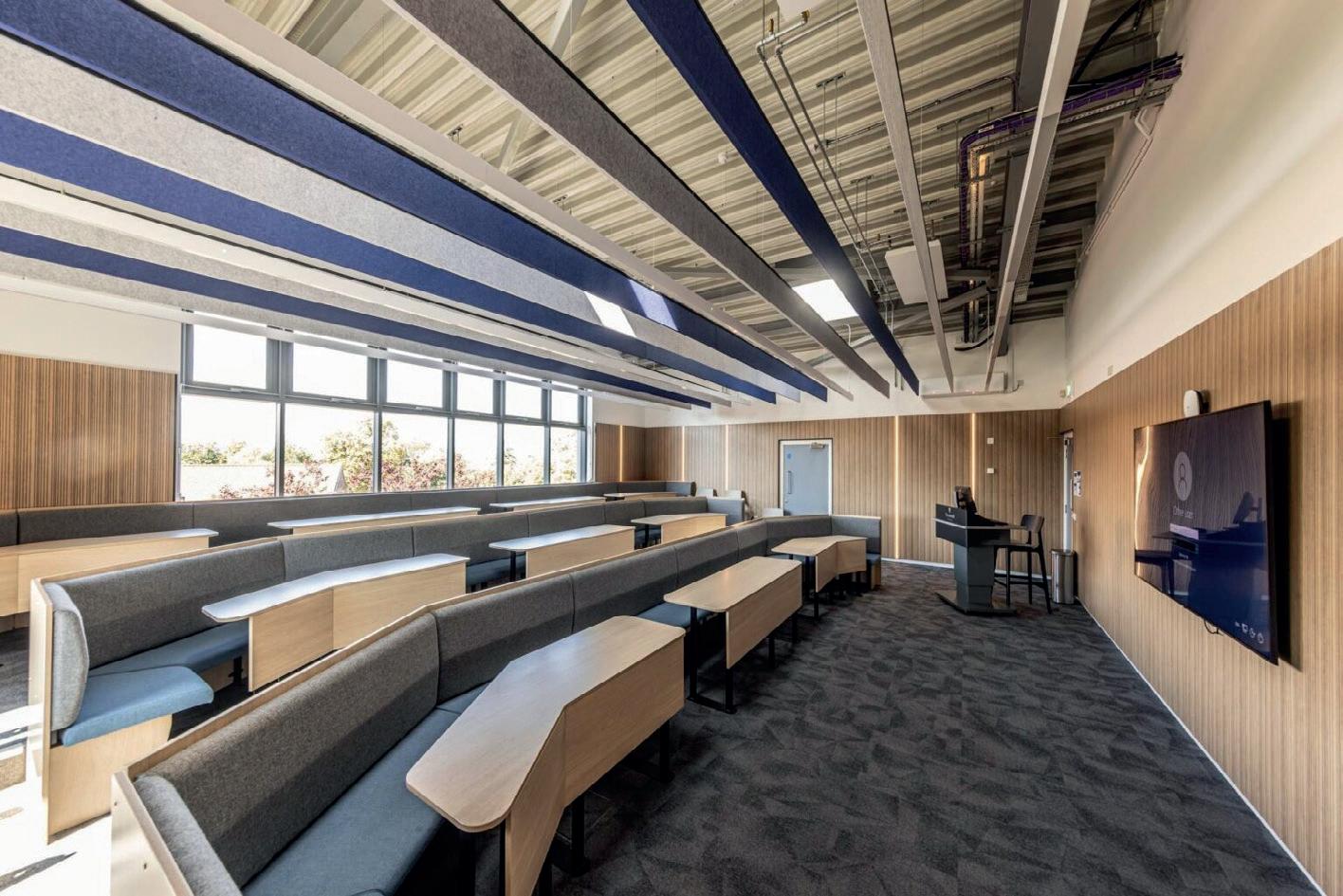

Building Design EDUCATION-PROPERTY.COM JUNE-JULY 2024 | 29
Ceilings are a popular choice for installing acoustic treatments
Envoplan introduced acoustic materials to reduce noise in a sixth form school
Acoustic engineers can use sound-absorbing materials to reduce noise pollution in schools
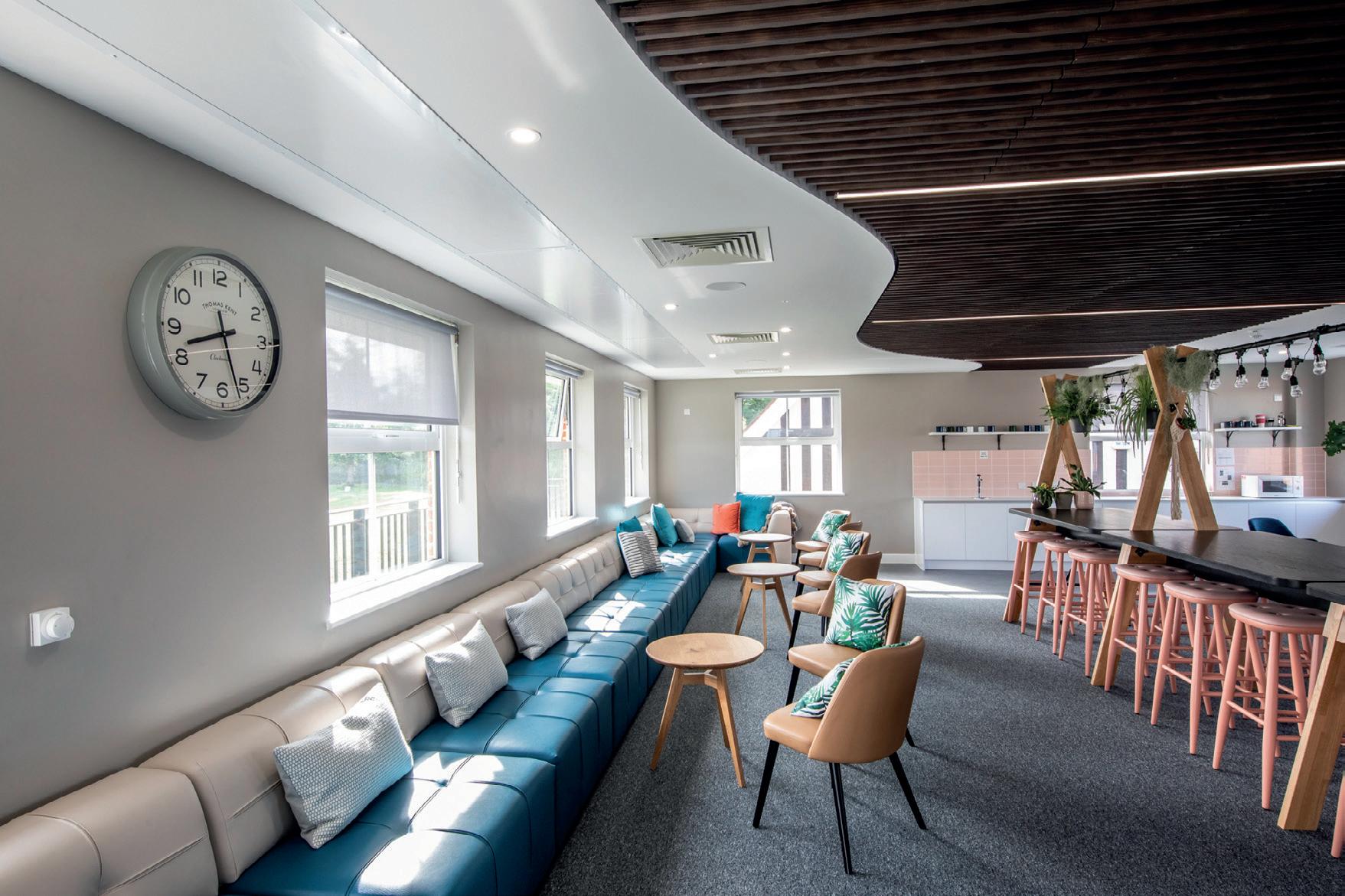
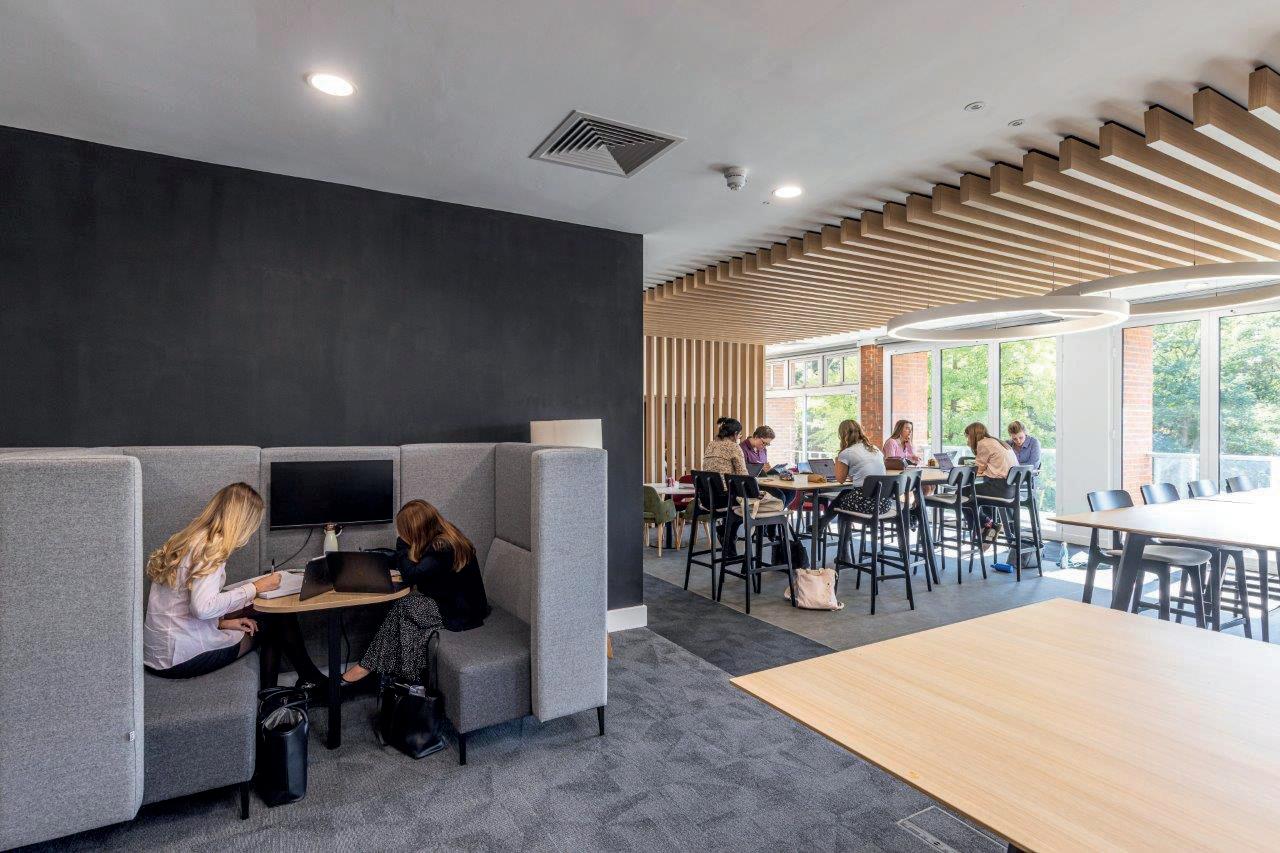
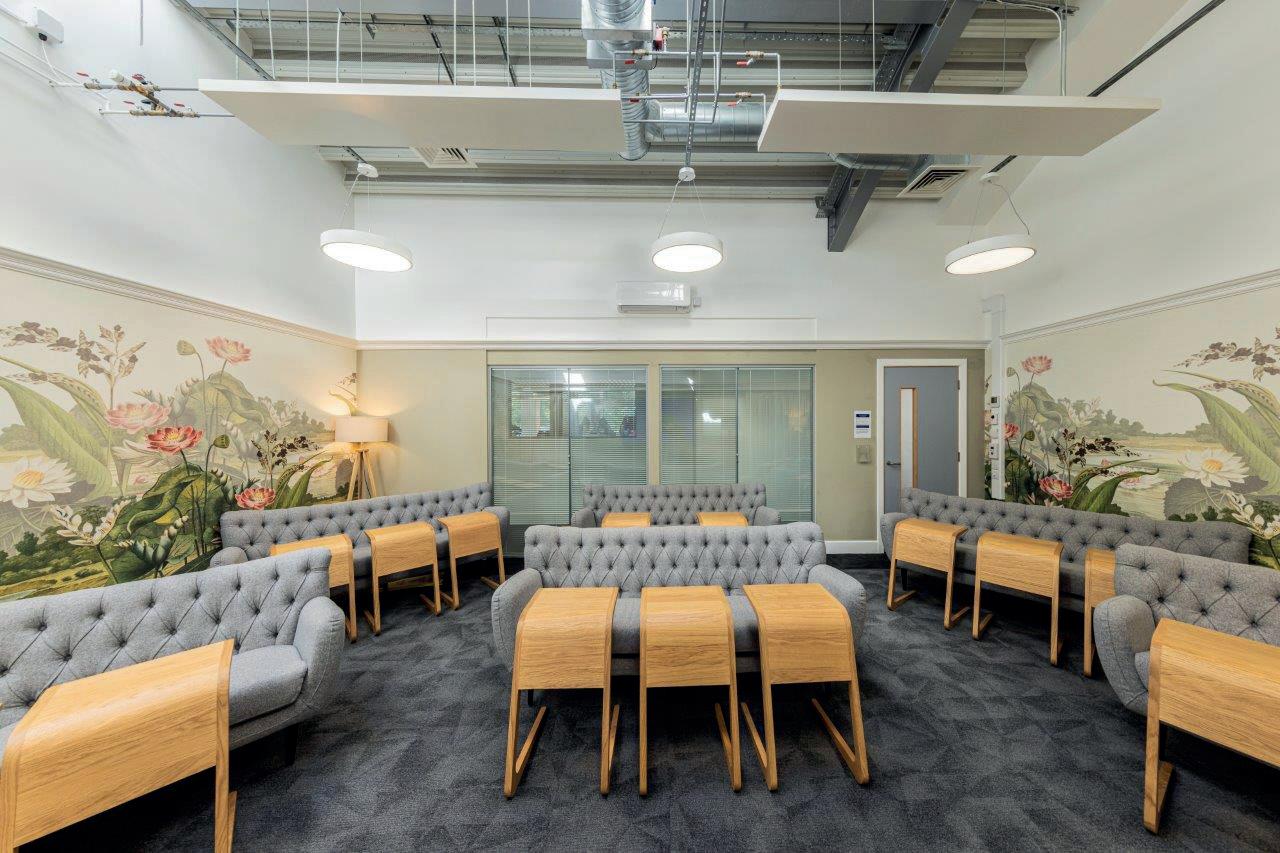
For as little as £20 you can buy an acoustic monitoring device and walk through a school to see where the main hotspots are for noise
Dr Adam England, director and executive consultant headteacher at Noble + Eaton, explains: “For as little as £20 you can buy an acoustic monitoring device and walk through a school to see where the main hotspots are for noise.
“We work closely with schools to trace how noise is moving within an environment and usually it is down to the choice of surface materials.
“In dining halls and corridors, in particular, there tends to be shiny, hard flooring and if you look at a surface and it appears shiny and reflective to the eye, then it will be acoustically reflective too.
“Flooring sound travels upwards, so if the flooring is reflective and so is the ceiling, then sound will bounce around a room, amplifying the effect and making learning more difficult.”
This has led to an increase in the use of sound-absorbing materials, including cork, and technologies such as baffles in educational environments.
SOUND ABSORPTION
Sound absorption is the term used to describe ways in which sound reverberation and echoes in a space are reduced via absorption in order to enable a cleaner sound quality.
These materials can be porous or nonporous and may include things like foam, open-cell mineral, fiberglass, fabrics, cushions, throws, curtains, or carpets.
Unlike soundproofing, which creates a barrier against sound entering or leaving a space; sound absorption reduces reverberation and improves the clarity of sound, with treatments dampening the intensity of sound waves, preventing sound waves from reflecting off hard surfaces, and mitigating their resulting echoes and reverberations.
Tuffin said: “There is increased use
30 | JUNE-JULY 2024 EDUCATION-PROPERTY.COM Building Design
Bespoke solutions can reduce the visual impact of acoustic treatments
Different solutions can help to divide spaces for private and communal activities
Acoustic treatments can be retrofitted into existing spaces to address issues with noise
of modern methods of construction (MMC) within the education sector and this provides huge scope for introducing acoustic materials.
“The choice of initial construction materials, as well as ceiling, wall, and flooring materials, is crucial. Then we can also look at internal surface finishes and even fixtures and fittings — pretty much anything can be used, both internally and externally, to mitigate noise.
“The best approach is to specify highlyabsorbent materials and apply them to as many sides of the box as possible.”
MATERIAL CHOICE
When planning a new school building, England advises first looking closely at room adjacencies to ensure that art rooms, music rooms, and gymnasia are sufficiently separated from the more-quiet areas where work takes place.
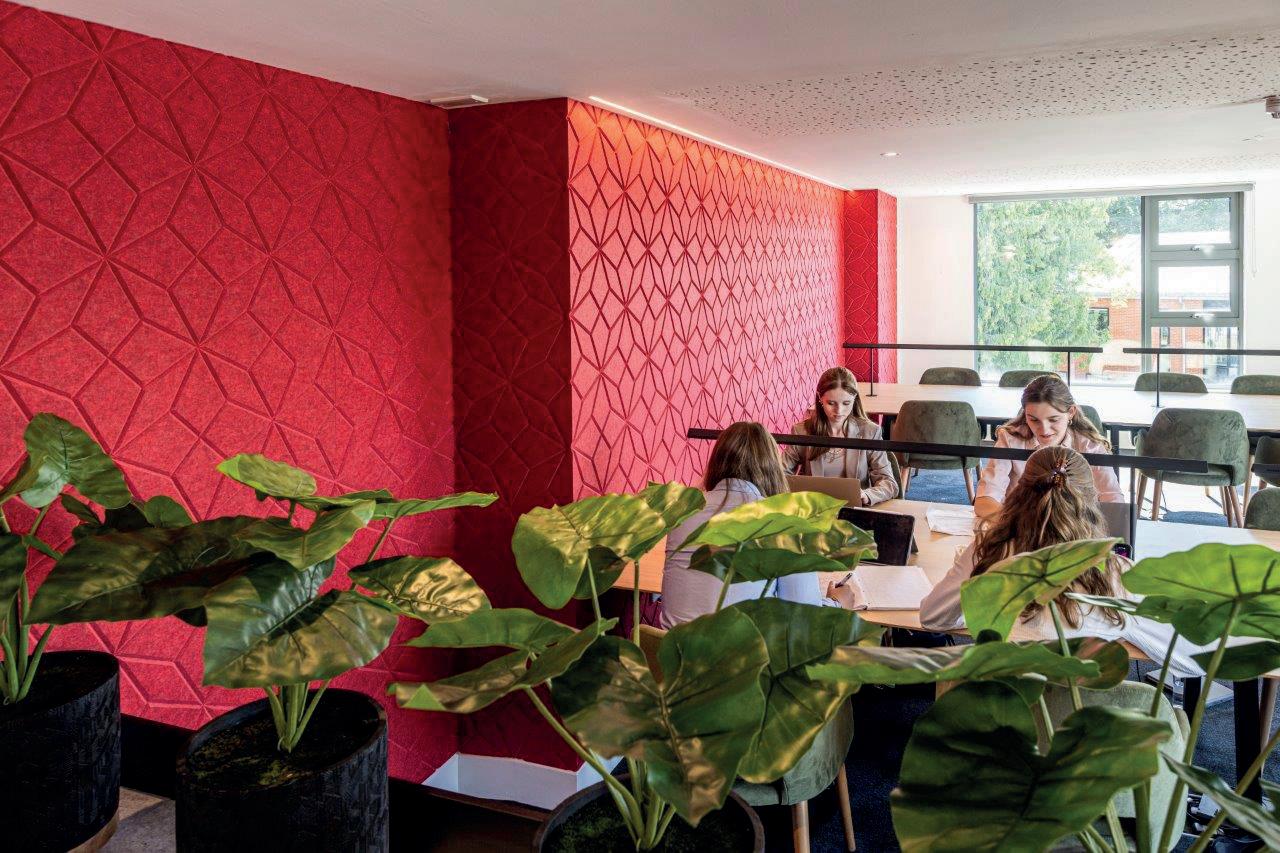
Heating, ventilation, or air conditioning systems should also be distanced from learning spaces, while many rooms will require absorbent material placed high on the walls.
Larger communal rooms, such as assembly halls, benefit from an angled reflective panel over the speaking area so that the teacher’s voice projects clearly.
Even things such as bookcases and corkboards can help absorb sound reflections.
And evidence suggests that the shape of baffles can also play a part in how effective noise-reducing interventions are.
England said: “Hexagonal and rightangled triangles are increasingly being used as they are able to evenly distribute sound waves, which results in better acoustics and fewer echoes.
“Hexagon sound panels are also effective at absorbing high frequencies, which makes them ideal for use in spaces with lots of hard surfaces.
“And triangles are often used as, when placed together, they create hexagons and work in much the same way.”
He adds: “When I was a teacher I had a pupil fidgeting in class so I got them down the front to sit next to me.
“I didn’t know then what I know now; that I was putting all the noise behind them and really lighting up their medulla and creating problems with concentration and mood.
“An effective acoustical engineer can recommend appropriate additions designed to reduce noise.
“With the right support and preparation, any administrator can transform their school into an acoustically-sound environment.” n
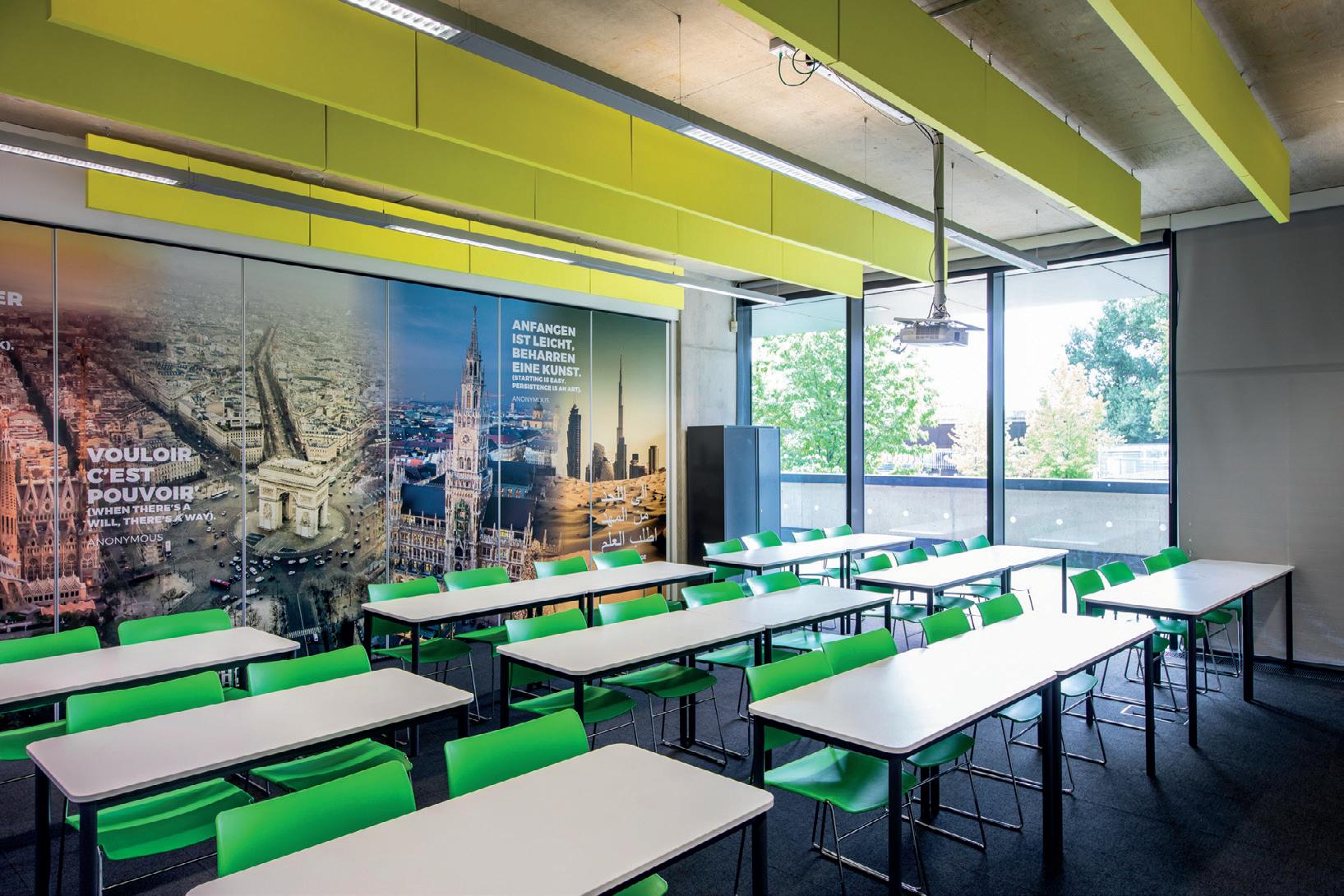
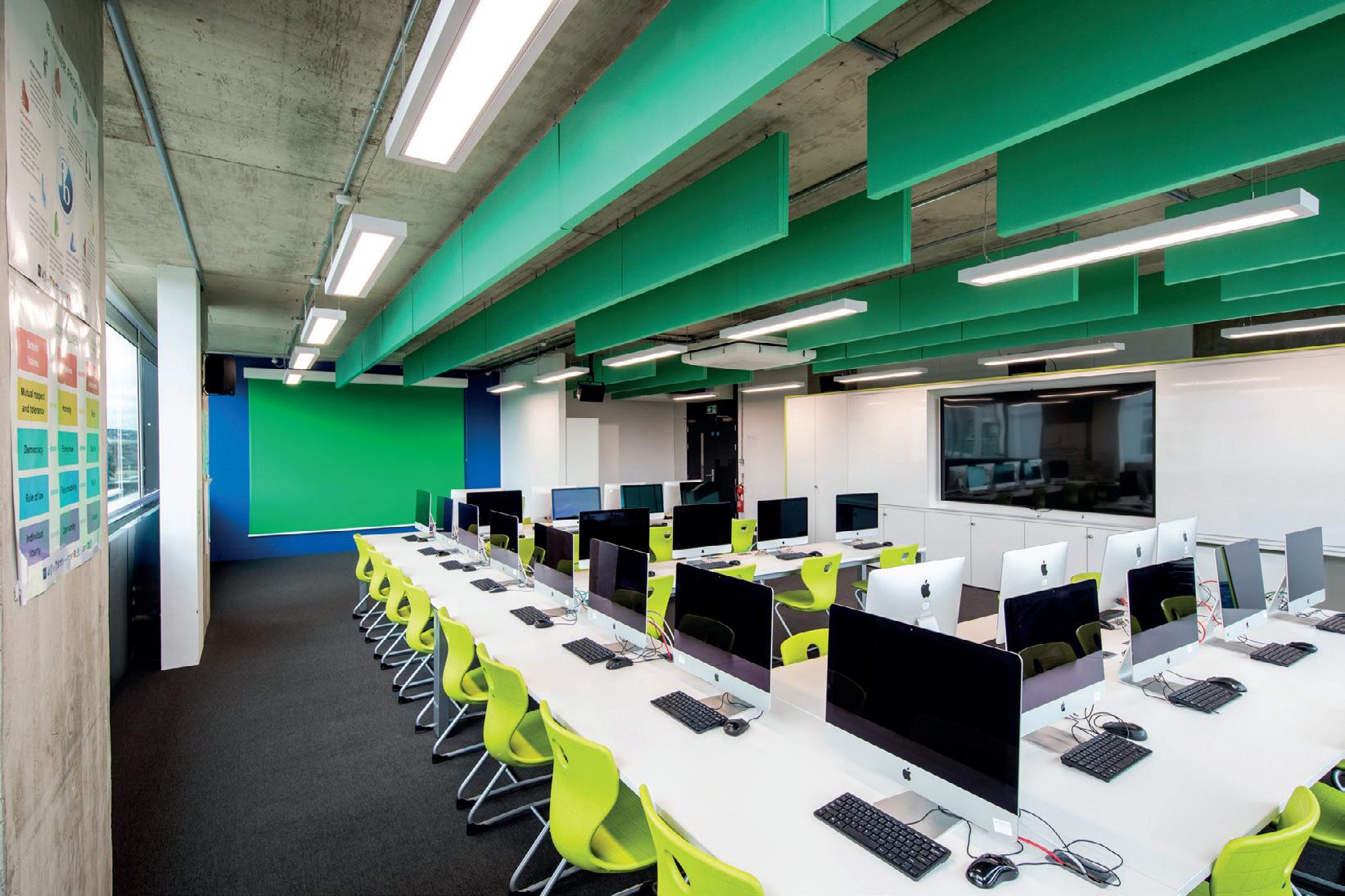
Building Design EDUCATION-PROPERTY.COM JUNE-JULY 2024 | 31
Envoplan installed acoustic panels as part of a refurbishment project at Westminster Academy

Mapping out a solution
Anderson Acoustics was commissioned by Baxall Construction to provide design advice in relation to a proposed £5m new-build double-storey teaching block and single-storey canteen building for Gravesend Grammar School.
The specialist was also asked to provide a noise impact assessment for the proposed new Multiple Use Games Area (MUGA) sports pitches and car park area.
3D environmental noise mapping of the site helped to establish acoustic performance standards and strategy plans for noise ingress and building envelope design, ventilation, internal sound insulation, and control of reverberation time.
A hybrid ventilation strategy was specified using individual low-carbon heating and ventilation units for each teaching space, which provide attenuation of external noise into the building and keep system (fan) noise levels low during normal ventilation conditions.
A lined timber roof cassette to provide good control of rain noise; precast concrete plank floor with concrete screed on insulation to control both airborne sound and impact; and SIPS panel partitions with
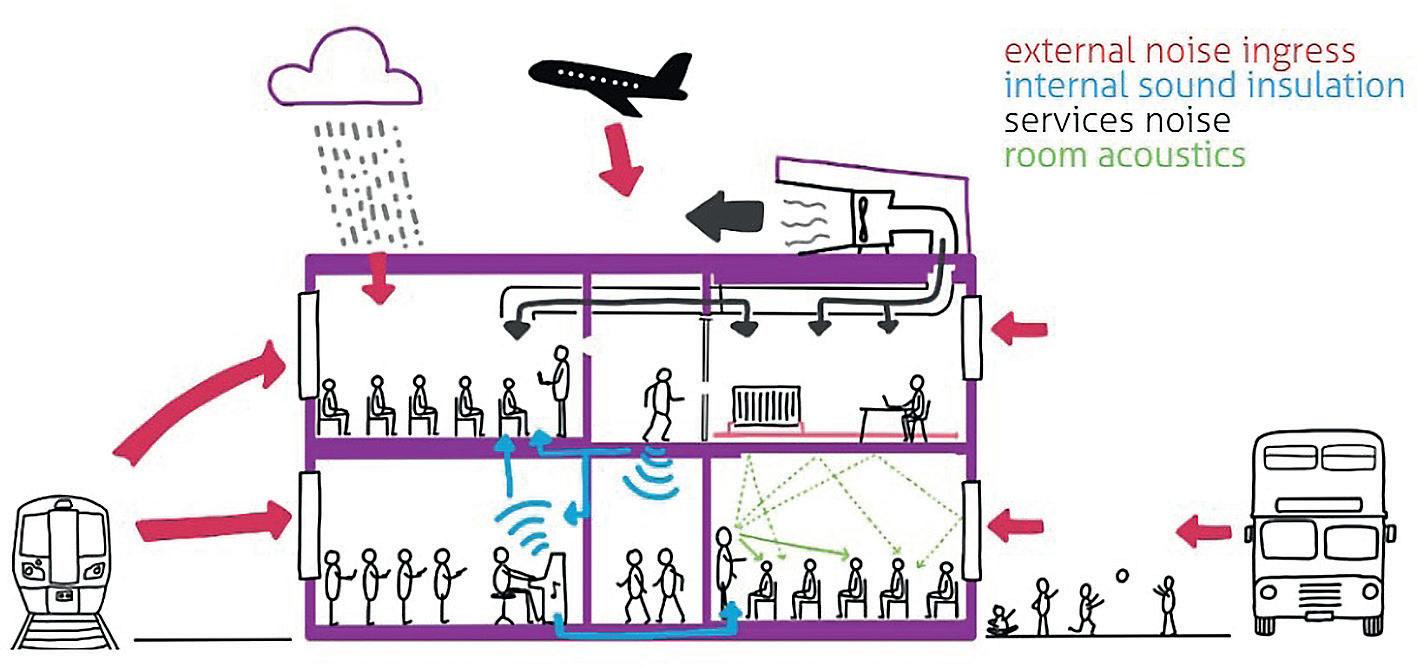
dense cement particle board, efficiently designed to meet the minimum airborne sound insulation targets were also advised.
Careful detailing of wall, floor, and ceiling junctions also helps to meet sound insulation performance targets while balancing other design constraints.
And Class A suspended ceiling tiles in teaching spaces and offices help to control of reverberation time in classrooms (estimated to be less than 0.6 seconds once furnished), to benefit listening conditions
for all children.
In the canteen, suspended acoustic baffles provide control of noise build-up and a reverberation time of less than 1.0 seconds; while in corridors, Class A ceiling tiles provide control of noise build-up during lesson changes.
Acoustic commissioning tests were carried out and all minimum acoustic performance standards were achieved as a result of the project, even for the unfurnished classroom condition.
32 | JUNE-JULY 2024 EDUCATION-PROPERTY.COM Building Design

DIFFERENT, BETTER, AND CALMER
Thackley Primary School in Bradford was experiencing acoustic problems in its main hall, an open-plan room used for assemblies, performances, PE lessons, and dining.
“The hall is used both for dining and for formal events, so outstanding acoustic performance was a key requirement.


Details of dimensions and photographs of the building were sent to Sound Reduction Systems (SRS), where experts were able to model the space using software before a member of the team visited the site to discuss a solution.
SRS director, Alex Docherty, said: “As soon as I was shown into the hall, it was clear that the acoustic environment was not ideal — the long reverberation time made it difficult to hold a simple conversation between a few people comfortably, let alone when the hall was full with children.
The estimated mid-frequency reverberation time was coming out at (Tmf) of 3.57s, which is far too high for a room of this nature.
“We calculated that 75sq m of our decorative Sonata panel absorbers would be required to solve the problem, bringing the reverberation time down to (Tmf) of 1.13s, and we provided the school with a layout design detailing where the panels would be installed within the hall.
“The school chose a combination of suspended Sonata Vario panels and bonded Sonata Aurio panels.”
Head of the School, Annette Patterson, said of the project: “The impact of the panels has been simply fantastic. What a difference!
“Lunchtimes are now completely different, assemblies are better, and PE lessons are calmer.”
SILENCE IS GOLDEN
The StoSilent Direct acoustic ceiling system has been installed at Somerville College as part of a major project to upgrade both the acoustics and the lighting of the Grade II-listed dining hall.
“This was a complex project where the aim was to create a much-improved acoustic environment in the hall,” explains Sto’s acoustics project manager, James Gosling.
“The aim was to increase the amount of acoustic attenuation material within the moulded panels of the existing vaulted ceiling, but the chosen acoustic system also had to be sufficiently flexible to accommodate the new lighting system which was being installed.
“The project demanded close liaison between ourselves, the architect, and the applicator in order to design and install the most-effective and appropriate solution possible.”
Specified by Associated Architects, the StoSilent Direct system offers a particularlyeconomical method of minimising reverberation times and reducing noise levels as it can be applied directly to walls and ceilings without the need for a subconstruction — a feature which also makes it quick and easy to install.
And the acoustically-porous nature of the materials and finish textures mean the system is highly sound absorbent and, in addition, has a reaction to fire classification of A2-s1, d0 in accordance with EN 13501-1
Thomas Cotton of Associated Architects said: “Refurbishing buildings of this age comes with particular challenges, so it was important that we worked with a proven acoustic ceiling supplier and installer who understood our requirement for highperformance absorption with minimal visual impact.”
BEING A GOOD SPORT
Hotham Primary School in Putney, south west London, contacted Resonics to provide an acoustic solution within its sports hall following complaints of a harsh noise environment.
Comprised of hard, reflective wall, ceiling, and floor surfaces, the hall was experiencing a lengthy reverberation time, amplified by the noise of groups of students and sport activities taking place.
Imperative was the need to reinforce the robust, high-impact construction of the hall to continue to allow for recreational sport.
To address the problem, Resonics installed a series of colourful, high-impactresistant acoustic wall panels, tailored to the hall’s unique shape.
The high-performance acoustic panels create the perfect sound environment in the hall; reducing the reverberation time to a comfortable level while still facilitating clear verbal communication.
And their impact resistance meant the hall could remain as a place for recreational sport with the peace of mind that the acoustic environment will not be compromised.
REDESIGNING FOR WELLBEING
Envoplan worked to help reimagine spaces at the sixth form centre at Tormead School in Guildford.

It was crucial that the resulting space met academic requirements and prioritised students’ wellbeing.
Central to the approach was to open the existing walls and introduce glazed elevations to brighten the spaces and effectively manage natural light.

But this also meant controlling noise nuisance, so wooden ceiling baffles were installed in the main common room and acoustic panelling was specified for the lecture theatre.
Furthermore, the furniture booths were acoustically treated, creating a harmonious blend of aesthetics and functionality.
An Envoplan spokesman said: “The redesigned spaces managed natural light effectively, creating a brighter atmosphere and the innovative acoustic treatments made the space more approachable, instilling comfort and safety.” n
Building Design EDUCATION-PROPERTY.COM JUNE-JULY 2024 | 33

Let there be light!
New research is revealing the impact of lighting design on SEND school pupils
Over recent years there has been an increased focus on research into how the design of educational establishments can impact on learning behaviours and outcomes.
But one element which is often overlooked is lighting.
A study of 21,000 elementary students in the US in 2009 showed that, over one academic year, children who were exposed to more sunlight during the school day displayed 26% higher reading outcomes
…children
and 20% higher maths outcomes than those in less-sunny classrooms.
In the UK, however, little research has been carried out and the Department for Education’s (DfE’s) Lighting Guidance 5: Lighting for Education document, which is the go-to for designers, has not been updated since 2011.
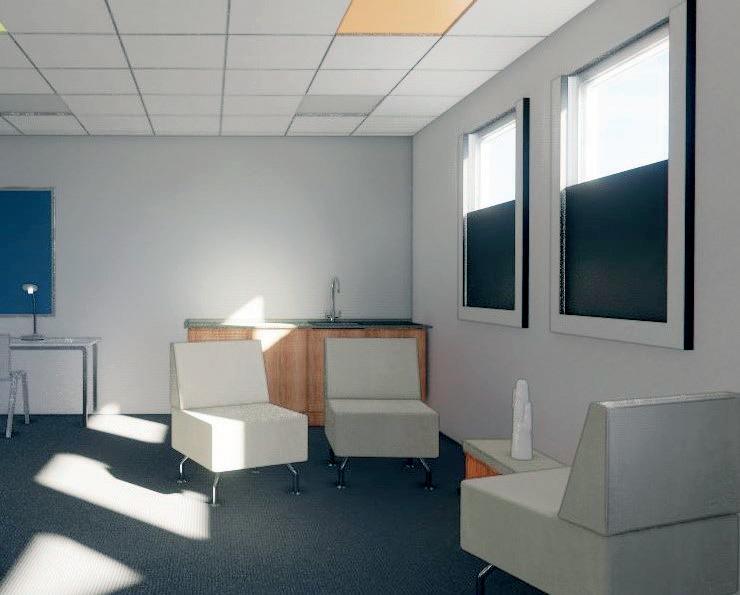
To address this shortfall in evidence, University College London (UCL) has collaborated with Dr Shelley James, an international expert on light and wellbeing at Age of Light Innovations; architectural practices, Haverstock and Noviun Architects; and The Hawthorns School and Yeoman Park Academy to ascertain the general awareness of the importance of lighting and find simple, affordable retrofit solutions that could be applied to spaces to enhance the learning and wellbeing of pupils with special educational needs and disabilities (SEND).
who were exposed to more sunlight during the school day displayed 26% higher reading outcomes and 20% higher maths outcomes than those in less-sunny classrooms
TAKING CONTROL
Speaking to Education Property, Dr James said: “The school output specification — Lighting Guide 5 — was published more than a decade ago and is based on nine light fittings in a grid with little or no option for control — the lights are either on, or they are off!
34 | JUNE-JULY 2024 EDUCATION-PROPERTY.COM Building Design
Window screening can reduce distraction from outside while still bringing daylight into the room





“There really is a need to make sure that our teaching environments are appropriate and allow pupils to flourish.”
The research centred on SEND schools as there has been little academic focus on these very-specialised environments, and particularly on the impact of lighting on neurodivergent pupils.
Lighting
can improve sleep.
Research has found that children exposed to brighter morning light fell asleep earlier that day, woke earlier the following day, and went to sleep earlier that night too

However, previous research has found that 54% of children with autism struggle with visual discomfort in the classroom and this is directly linked to poor concentration, anxiety, headaches, and behaviour issues.
SEND pupils also struggle with getting a good night’s sleep and this has a knock-on effect on their learning.
Dr James explains: “Lighting can improve sleep. Research has found that children exposed to brighter morning light fell asleep earlier that day, woke earlier the following day, and went to sleep earlier that night too.
SELF REGULATING
“If children spend the day in 300 lux lighting conditions, which is recommended in classrooms, then go home to a computer or TV, they live in a kind of twilight zone and their body clocks start to free run, with disastrous consequences.
“Variable light, therefore, is hugely important to help students self regulate.
“When we give teachers lighting controls as part of the tools they can use, we see some extraordinary results.”
The first phase of the collaborative research concentrated on teachers’ awareness of the impact lighting can have on pupils’ concentration and learning in two SEND schools and what research already exists into the impact of various solutions.
To further teachers’ awareness, the first phase used simple retrofit solutions to ascertain what might benefit the pupils the most.
And it is hoped that, while the study has concentrated on SEND schools, it will have wider ramifications for mainstream settings in the future to assist neurodiverse pupils.

Building Design
EDUCATION-PROPERTY.COM JUNE-JULY 2024 | 35
A cosy corner within the main classroom uses twinkling lights and a reduced ceiling height to provide an intimate sensory space
The study looked at how different lighting solutions could be used in different areas of the classroom
Building Design
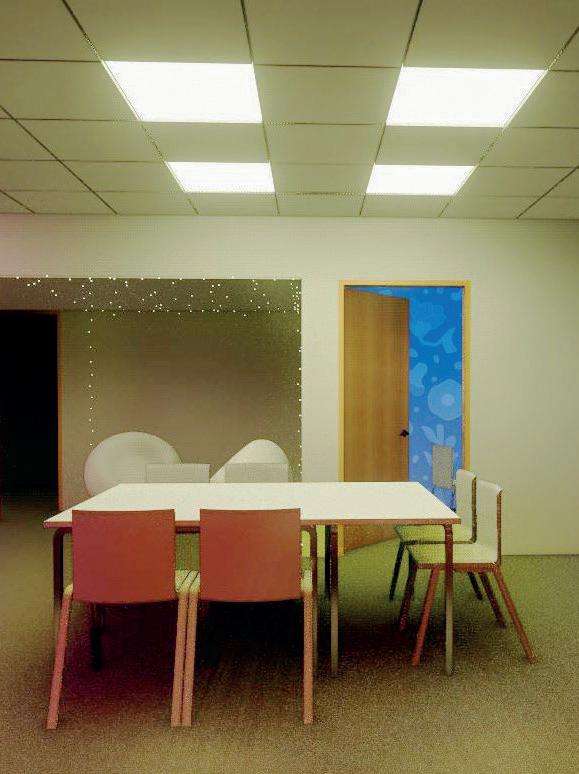
circadian rhythm; colour-changing panels and LED strips, which were placed around noticeboards and in corridors; fairylights; and interactive wall tiles. There was also a small colour-changing chick which was one of the most-popular interventions among both staff and pupils, helping to signify mood and to calm pupils, working particularly well for non-verbal pupils.
The coloured LED lights could be altered to reflect the days of the week and time of day, helping to maintain all-important circadian rhythms. The schools also found standard tracing paper on the windows was highly effective.
Pupils, in particular, had fun with the colour-changing light strips and verbal and non-verbal pupils used the interactive chick to display mood and to help them self regulate.
KNOWING BETTER
But, key to their success at both schools was the element of control, enabling both teachers and pupils to vary light levels and colour at particular points in the day or for specific tasks.
Dr James said: “Traditional school lighting solutions are not designed relative to how we teach. The teacher might be standing at the front of the room and the children can’t see them!
“Many of us have smart lighting in our homes and yet we are still using gridded

ceilings with standard light fittings in our schools. Why are we still doing that knowing what we know?”
Zane Putne, SEND director at Noviun Architects, adds: “Lighting controls do not really exist at the moment in schools. We are keen to find potential solutions, not just to make future schools better, but also to find retrofit solutions for existing buildings.
“Pupils with ADHD and autism, for example, can be more affected by extreme colour contrast and glare and this impacts on their ability to cope and concentrate at school, which is already a stressful place for many.
“SEND schools use different spaces for different things and it is important that lighting can be controlled within these spaces to create zones for various activities.”
BEYOND COMPLIANCE
With schools on strict budgets, the researched focused on lighting solutions which were flexible; able to be retrofitted into existing, often outdated, buildings; and which were affordable and sustainable.
Dr James said: “Even though the lighting complied with current regulations, teachers were clear that the legal minimum is not sufficient for them to support their students effectively, especially the ability to adjust colour temperature and brightness for different activities across the day.
“Compliance is not enough.
“Building standards for modern workplaces reflect new knowledge and support diversity, but education is falling behind.
“Simple, affordable retrofit solutions have
clear potential to improve outcomes and teacher satisfaction and teaching teams are ready to invest and make the effort — if they understand why.”
The team is now taking the findings from phase 1 of the study to inform the next stage, which will run from September to March and will explore more-permanent lighting solutions across a larger number of schools.
Putne said: “We need to be pragmatic and focus on retrofit solutions within tight budgets.
A GAME-CHANGER
“During the second phase we will work with the Building Research Establishment (BRE) and lighting specialists to continue our research, concentrating on how we can evaluate the results and how to integrate elements of lighting into every school.
“We will look at how learning spaces are used in real life and how each space within a classroom can use lighting in a way that supports pupils and teachers and the function of that space.
“What we want to produce is a kit of parts that can be put in any school.”
Anna Monaghan, an associate at Haverstock, adds: “Currently many schools are in temporary accommodation or older buildings. If we can make lighting work here, then we can do it anywhere. This research could be a game changer for all.
“Schools have limited space, so we need to look at how rooms can be split up and how lighting and lighting controls can be incorporated into these rooms to perform for lots of different activities.”
n
The main learning space in the centre of the classroom uses grid ceiling lights that can change colour tone throughout the day to work with children’s circadian rhythm
36 | JUNE-JULY 2024 EDUCATION-PROPERTY.COM
Interactive lights and coloured ceiling grid lights draw attention to, and maintain focus on, the main teaching wall








Kristine Scott Harrison Clark Rickerby “Go Commercial! The benefits of ditching charitable status and how to go about it” Sir Anthony Seldon Durell Barnes The implementation of the Independent Schools Inspectorate's new inspection framework, highlighting what to watch out for Daniel Cohen MTM Consulting “Admissions: how to get it right & strategies to attract more parents” Carolyn Reed Reed Brand Communications “Engaging with parents more effectively” Keynote Speaker David Woodgate CEO of Independent Schools’ Bursars Association “Remodelling your school business” 9 October IET London: Savoy Place Exclusively for headteachers, bursars and senior management Confirmed Speakers REGISTER NOW independentschoolmanagement.co.uk

Benefits of technology in cleaning: what education can learn from cobotics
We look at the ways technology — such as floor-cleaning robots — can help to keep educational facilities clean and hygienic
Educational facilities can provide a range of unique challenges for estates and facilities management professionals, from ensuring high-footfall locations are always safe and clean despite hundreds of young people moving from class to class, to making sure cleaning and maintenance regimes fit around class timetables.
Here, Kristal Goodwin, national sales manager for Robert Scott’s cobotics division, explores how cuttingedge cleaning robots could be the perfect partner for operatives working in these environments.
A GROWING TREND
The cleaning sector is experiencing a significant transformation with the introduction of advanced robotics and intelligent management systems.
Smart connected technologies, the rise of the Internet of Things, and the development of AI have all made the switch to automated systems more straightforward.

38 | JUNE-JULY 2024 EDUCATION-PROPERTY.COM Estates and Facilities Management
Robert Scott has partnered with cobotic design expert, Metabots, to become the UK’s primary distributor of its cleaning robots. Pictured, Kristal Goodwin
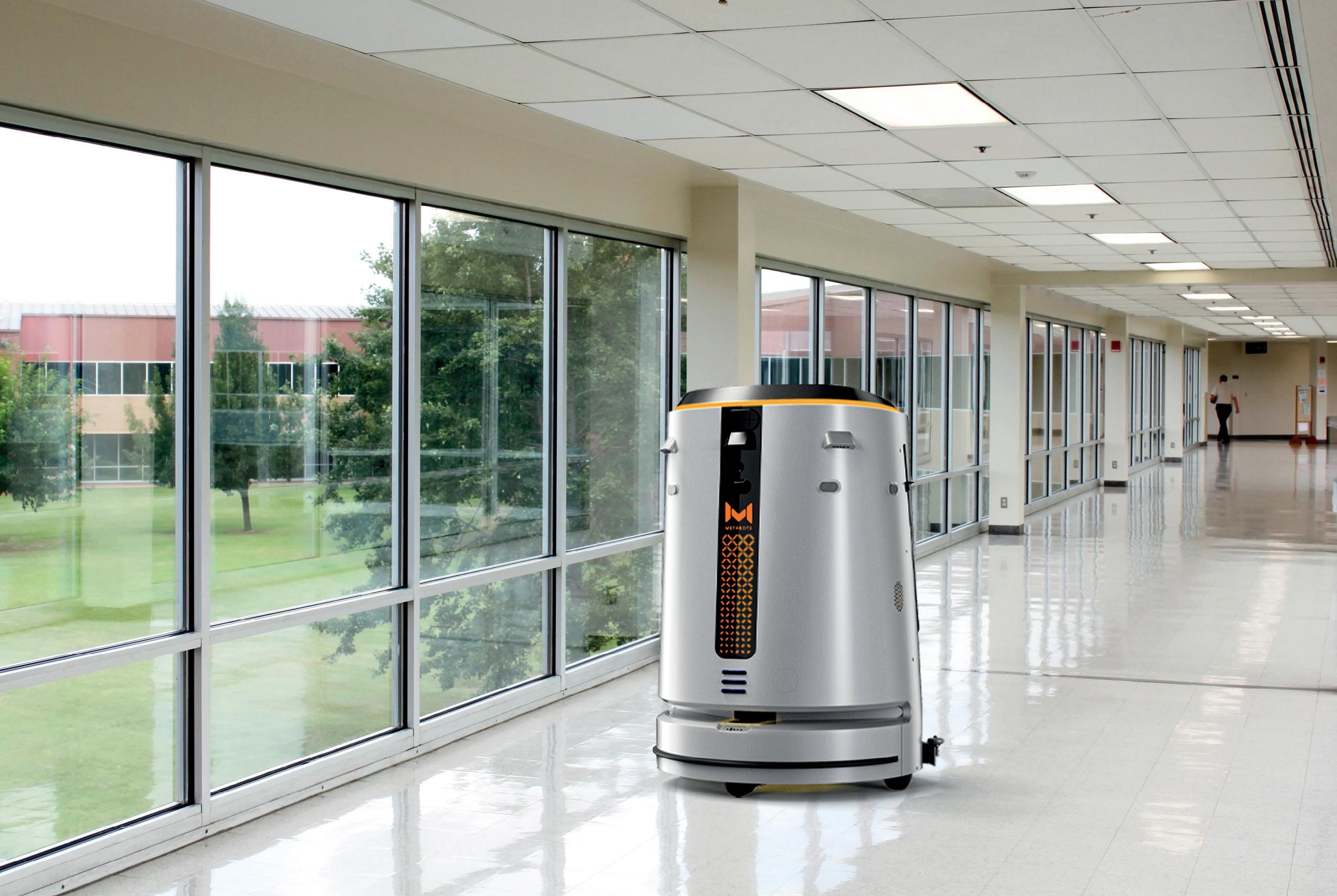
cleanliness and safety in spaces used by both students and staff.
INTEGRATING ROBOTS
There are a variety of robotic cleaning solutions available on the market today, each with its own benefits and limitations.
Among the various approaches, cobotics — where robots collaborate with human workers — stands out as a particularlypromising field.
In educational environments, cobots are invaluable for managing the cleaning of expansive areas such as hallways, assembly rooms, and sports halls.
They not only achieve consistently-high cleaning standards, but machines also complement human labour by freeing up staff to focus on targeted cleaning tasks, such as spot cleaning and deep sanitisation. And cobotics help to narrow the gap where cleaning staff shortages are concerned.
Cleaning, waste disposal, and other facilities management industries were
expected to create 93,000 new jobs by the year 2024 according to the British Cleaning Council. However, 29% of these positions have been classified as ‘hard to fill’.
These staff challenges are being echoed across the educational sector, with 82% of facilities reporting shortages of cleaning staff, according to a UNISON survey.
Adoption of technology provides tools that help cleaning operatives do more in the time they have, and by handling fewer monotonous tasks, operatives can gain greater job satisfaction which, in turn, supports better retention levels.
Combining cleaning robots with human workers results is a much-more-efficient, flexible, and inclusive approach than systems designed solely to replace human labour.
Equipped with state-of-the-art sensors and artificial intelligence, cobots help to avoid redundant cleaning efforts and conserve resources such as water and detergents, while also minimising site management maintenance costs.
THE BENEFITS
These machines are expertly designed to ensure an optimal clean and boast userfriendly operation, ideal for maintaining large, open spaces that ordinarily would take a lot of human time to do the same job. Take, for instance, autonomous floor scrubber driers. They can come equipped with a variety of attachments capable of scrubbing, sweeping, polishing, and drying a floor, with the latter a key aspect to ensuring that accidents from wet floors are eliminated.
It is important to look for a machine that is engineered with precision navigation, can clean close to the edge of the room, and can detect objects, even if very small. Additionally, they should feature advanced obstacle avoidance to keep students and the facility safe and free from damage.
Machines with a zero-degree turn radius will manoeuvre into and clean tight spaces. Equally, operatives do not need to be tasked with disposing of wastewater and refilling with freshwater during cleans, so opting
Estates and Facilities Management EDUCATION-PROPERTY.COM JUNE-JULY 2024 | 39
Robot cleaners are invaluable for expansive areas in schools, such as corridors and halls
Estates and Facilities Management
… these machines can be programmed to carry out cleaning tasks when schools are closed to ensure continuous floorcare is conducted without disruption to the educational process
for machines that handle this, as well as charging, by autonomously returning to its integrated docking station will bring the most benefit.
Furthermore, these machines can be programmed to carry out cleaning tasks when schools are closed to ensure continuous floorcare is conducted without disruption to the educational process.

Estates and facilities managers can also benefit from intelligent performance data capture and tracking features.
For example, they can optimise cleaning schedules based on comprehensive data, such as area coverage and operation times, and set benchmarks and evaluate performance against established KPIs for continuous improvement.
And machines that offer a simple user interface and tamper-proof control panel will ensure only those who are trained and granted access can operate the machine.
Cobotic solutions generally use less cleaning products and water than traditional floor cleaning approaches. In fact, some require no water whatsoever, using bacteria-removing microfibre to clean floors. This helps reduce slip risks as well as cutting down on waste water.
Modern battery-charging cobots can be powered for as little as 35p per hour, with a battery life of up to 20 hours.
EASY TO INTRODUCE
Cobotic machines with user-friendly design will ease the transition to advanced cleaning technology.
Users typically find that with just a brief training period, they can operate the machines with confidence and skill.
Working with a supplier that has dedicated
to optimise cleaning regimes in schools
cobotic expertise will ensure a seamless onboarding process through comprehensive training, in-personal installation of the equipment, and ongoing support for troubleshooting and maintenance.
Simple tasks such as wiping and inspecting attachments and flushing out the hose should be all that is required by users.
In addition, existing technology is sophisticated enough that major infrastructure changes should not be needed to introduce cleaning robots.
PRACTICAL LESSONS
Another somewhat-unconventional benefit of cleaning robots is their capacity to fascinate and intrigue.
Educators constantly seek resources
that can captivate and educate students in dynamic ways.
Integrating state-of-the-art intelligent cobots into cleaning routines within educational institutions offers an engaging, real-world illustration of technology in action.
For students delving into subjects like physics, engineering, mathematics and ICT, these autonomous cleaning robots can serve as tangible case studies of the principles they’re learning in class.
Cobotic cleaning systems offer an exciting future across a range of sectors.
In educational settings, they offer some particular benefits: from reducing disruption to students, to inspiring the next generation of engineers. n
Integrating state-of-the-art intelligent cobots into cleaning routines within educational institutions offers an engaging, real-world illustration of technology in action
40 | JUNE-JULY 2024 EDUCATION-PROPERTY.COM
Modern cobots can provide data which can be used
Partnership approach to optimise estates
Facilities management consultancy, Litmus, has announced a new partnership with the Association of University Directors of Estates (AUDE), as part of its mission to support the higher education sector.
AUDE promotes excellence in the strategic planning, management, operation, and development of higher education estates and facilities.
And, under the new collaboration, Litmus will work with members to inform them of key trends and share best practice on the delivery of all facilities managementrelated services to help drive efficiencies, improve value for money, and boost services to stakeholders.
Kate Davis, senior consultant at Litmus Partnership and AUDE relationship project lead, said: “It’s a privilege for us to partner with AUDE; a highly-regarded organisation that mirrors many of our values and ethics.
“The higher education sector has faced turbulent years recently following the pandemic, the energy price crisis, and adapting to new ways around how university buildings, facilities, and campuses are used.

is expertise we can provide through this partnership.
management and change management and getting best value at the right price.
“Through our experience and deep understanding of the business processes involved in delivering specific, sometimes highly-specialised, FM-related support services, we’re able to bring exceptional value by exploring all the options, constructing viable solutions and implementing new ideas and ways of working.
“We’re dedicated to creating moreefficient facilities management processes and carbon-neutral environments through positive engagement with our clients and their product and service supply chains.
“We believe this transforms the value of support delivery – ultimately costing less and giving much more.”
Speaking to Education Property about the collaboration, John Brownless, joint managing director of Litmus, adds: “From speaking to estates professionals, we found that many do not have time to do certain things. Anything strategic, for example, is a challenge.
“They want to understand things like competitive pricing and best value and this
“Most of us have come from the supply sector so the network is strong and we have a good understanding of what is going on in FM as a whole.
“We will also be bringing our experiences from other sectors we work in, like government and the NHS, and taking innovation and learning from these to AUDE members.”
One of the first focus areas, he said, was for Litmus to benchmark cleaning regimes.
Brownless said: “It’s about people
“We will be benchmarking cleaning, for example. Currently Enterprise Risk Management (ERM) reporting is quite holistic and does not get into the granular, like pay rates and shift patterns and materials and equipment.
“All these things are cleaning costs and we need a full understanding of these to inform a different approach that delivers best value.
“Overall, our aim is to provide a fresh viewpoint and show want we could do better.”
We’re dedicated to creating more-efficient facilities management processes and carbonneutral environments through positive engagement with our clients and their product and service supply chains
Estates and Facilities Management EDUCATION-PROPERTY.COM JUNE-JULY 2024 | 41
Image: Gerd Altmann from Pixabay
9 challenges facing higher education estates managers
There are nine key challenges facing education estates professionals, according to client feedback received by facilities management recruitment specialist, 300 North.
According to the Higher Education Estates Management Report 2018, it is estimated that university estates now spend an estimated £3bn a year on capital projects.
And, over the years, the role of estates management teams has moved beyond just maintaining and constructing buildings and infrastructure.
They now have a commitment to providing staff, students, and visitors with quality facilities and services while helping to shape the future role of the estate as a physical environment.
Based on feedback from clients, including estates directors, 300 North has put together a list of the mostpressing challenges managers face.

1. Keeping up with and meeting the high expectations of the next generation of students
2. Balancing quality and cost while juggling a framework of compliance and tightening budgets
3. Beating off increasing competition from colleges and universities across the globe
4. Facing a time of uncertainty around Brexit and the impact this will have on higher education
5. Potentially being subjected
to a reduction in tuition fees meaning less money for capital projects
6. Managing growing estates with more complex needs
7. Constructing and managing new buildings with higher operating costs
8. Losing confidence in outsourced contracts thanks to the collapse of companies such as Carillion
9. Experiencing significant cuts in capital funding from the Government
Key to overcoming these challenges, according to 300 North, is the need to develop strategic decisions which are right for the individual needs of each higher education setting and its stakeholders.
What’s more, as highlighted in research carried out by Deloitte, colleges and universities must think globally to develop a strong student and stakeholder value proposition to distinguish them from their competitors.
“Within the higher education sector, the responsibility of creating a rich learning environment falls heavily on the shoulders of colleges and universities, in particular its estates and facilities management (FM) teams,” said a 300 North spokesman.
“Unfortunately, an uncertain future and cuts in funding are going to shape the higher education sector, but we must remember that college and university estates are critical to the success of any institution.”
Estates helpdesks merge to form one team
The University of Oxford has merged its two estates services helpdesks, creating a single point of contact for building users and managers, simplifying the user experience, and ensuring a more-efficient service.
On 4 March 2024, the first phase of the project to merge the two existing helpdesks went live, unifying the previously-separate FM and DLO helpdesks.
Merging these into a single support team aims to create a single point of contact for all our users for the first time.
It will help standardise processes and improve the estates team’s ability to respond quickly to requests and escalate issues as needed.
The work will also provide customers with clearer and more-accurate information on the progress of reactive work requests.
A spokesman said: “After implementing the initial changes, we will monitor the helpdesk’s usage statistics and user feedback and if any issues arise, they will be promptly identified and addressed.

“The team will receive additional training to ensure a smooth changeover to the new system.
“The helpdesk team will also review and standardise
the process for logging reactive calls, which will help streamline operations and all team members will have full sight of, and access to, all requests raised.
“This will mean they can easily view, amend, and log tasks, fostering a transparent, collaborative working environment.”
42 | JUNE-JULY 2024 EDUCATION-PROPERTY.COM Estates and Facilities Management
Image Gerd Altmann from Pixabay








Decarbonising higher education — The investment challenge

AToby Horne, smart infrastructure financing partner at Siemens Financial Services UK, discusses the critical role of flexible financing solutions in supporting higher education sustainability goals
s the global cost of climate change becomes more apparent, the UK remains committed to achieving net-zero emissions by 2050.
To achieve this goal, the Government and press have been vocal about how private businesses and households can meaningfully drive down their carbon emissions.
Equally, universities and higher education (HE) institutions have an important role to
play in meeting carbon reduction targets.
In 2021, over 1,000 universities and HE colleges worldwide pledged to become completely carbon neutral by 2050, with some institutions aiming to decarbonise as quickly as 2030.
This list includes 168 UK institutions.
And, while this ambition is laudable, it nonetheless represents a series of logistical and financial hurdles in a sector that continues to struggle for financial solvency.
almost half of all vice-chancellors expect their institutions to be in a financial deficit in 2024.
In order to fund the necessary infrastructure to achieve net zero, institutions therefore need specific, tailored finance programmes to ease the burden of green investment.
Here, we look at the true carbon cost of the HE sector, the retrofitting of buildings necessary to achieve carbon neutrality, and how the financial sector can aid institutions in removing the cost barriers to investment.
THE CARBON COST
The HE sector is a substantial contributor to global emissions.
44 | JUNE-JULY 2024 EDUCATION-PROPERTY.COM Environmental
Data from the Higher Education Statistics Agency demonstrates that 133 UK universities accounted for 1.4 million tonnes of carbon dioxide emissions between 2021-2022.
While two thirds of those managed to decrease their emissions over the past year, experts warn of ‘patchy’ progress within a sector that is failing to keep pace with current targets and the greater climate emergency.
Professor David Reay, director of the Edinburgh Climate Change Institute, told Times Higher Education that institutions cannot rely wholly on the decarbonisation of the national electricity grid.
And he reiterated the importance of ‘grasping the nettle of institution-wide enhancements to the energy efficiency of buildings, equipment and usage’.
Inevitably, this involves substantial investment.
“This is not cheap,” Reay warned, “and in these straitened times, the capital costs of things like building retrofit risk being put off, even though the savings over the longer term can far outweigh these costs.”
THE CHALLENGES
According to the International Energy Agency, in order to meet net-zero targets, not only must all new buildings be zerocarbon ready, but 20% of existing stock must be retrofitted for carbon neutrality by 2030.
While this represents a challenge for all sectors, it is particularly demanding for the HE sector.
The UK is home to some of the oldest and most-prestigious university campuses in the world.
Unfortunately, while the halls of Oxford or St Andrews may be steeped in history and architectural wonder, these very assets can curtail today’s ambitious ecological targets.
Retrofitting the medieval architecture of Britain’s oldest universities is an elaborate undertaking that requires a great deal of capital investment.
It is ultimately, however, an investment that can unlock great monetary and carbon savings for generations to come.
Data from Grosvenor suggests that retrofitting 50% of all the UK’s pre-1919 residential buildings over a period of 10 years could lead to carbon savings exceeding 39 million equivalent tonnes of CO2. And this would result in an estimated monetary saving of £3.4bn by 2050.
There are over 600,000 historic buildings in commercial use throughout the UK, accounting for almost a third of all commercial buildings so HE institutions have an opportunity to lead the charge and set an example for others.
Retrofitting the medieval architecture of Britain’s oldest universities is an elaborate undertaking that requires a great deal of capital investment
SMART BUILDINGS
The term ‘smart building’ refers to a building that makes use of available technologies to make its operations more efficient and economical.
There are already some very-impressive examples of HE institutions that have embraced new technologies.
The University of Birmingham, for instance, partnered with Siemens in 2021 to become the first university to implement a large-scale Internet of Things (IoT) rollout, installing 23,000 IoT sensors across its Edgbaston campus.
This measure will provide invaluable insights into building occupancy so the university can manage power and heating more effectively.
This is projected to reduce emissions across all campuses by nearly 3,000 tonnes of CO2 per annum.
Likewise, the University of East London has also partnered with Siemens to create a ‘living laboratory’ that will capture granular energy usage data to drive future change.
This data capture can be used in conjunction with other technologies such as ground and air source heat pumps, sensordriven LED lighting, automated door controls, energy-efficient insulation, and smart heating and ventilation solutions to reduce energy wastage.
In an era defined by inflated fuel prices, investment in green infrastructure cannot only drive down carbon emissions, but also drastically reduce operational spending, reducing energy use by up to 40%.
FINANCING NET ZERO
At a time when almost half of all UK universities anticipate a financial deficit, it is easy to see why HE institutions may baulk at the cost of decarbonisation.
Accounting specialist, Grant Thornton, calculates the cost of decarbonising the UK’s HE sector at £37.1bn. £25.4bn of this will be spent on decarbonising supply chain emissions, while £6.56bn will go towards built environment emissions and £5.14bn for transport and travel.
The UK Government’s sustainability and
climate change strategy acknowledges that school and university buildings account for 36% of total UK public sector building emissions.
And, while universities may bid for a share of a £230m fund to facilitate low-carbon energy upgrades for public sector buildings, this still leaves a significant shortfall.
Specialist financiers are poised to bridge this gap, with financing solutions that can be tailored to the specific needs of an organisation.
Buildings-efficiency-as-a-service (BEaaS), for instance, is a finance arrangement that can be leveraged either at the component or larger building level to facilitate investment in infrastructure without endangering cash flow. This arrangement aligns the cost of the technology with the expected rate of benefit.
And this means that institutions will not need to make large upfront payments, instead spreading the cost of investment over a flexible period.
The operational savings facilitated by this green investment can further help to offset the cost of investment, in some cases paying for zero-carbon renovations in their entirety.
As well as ameliorating upfront costs, these agreements often include guarantees based on expected energy efficiency outcomes and this further mitigates the risk borne by HE institutions.
LEADING THE WAY
The operation of buildings accounts for 30% of final energy consumption worldwide, and 26% of all global energy-related emissions.
Reducing this footprint can therefore seriously help to meet environmental targets.
With the right financial arrangements in place, HE institutions can afford to be much more pro-active in meeting their mostambitious targets for carbon neutrality.
Retrofitting university buildings into smart buildings can yield phenomenal carbon and operational cost savings, ultimately providing future generations of students and faculties with the gift of moreefficient and sustainable operations. n
Environmental EDUCATION-PROPERTY.COM JUNE-JULY 2024 | 45
New schools earmarked for areas of high pollution
New research from Evelina London Children’s Hospital and King’s College London has found that all new schools proposed to be built between 2017-2025 are currently, or will be, in areas of high pollution.
Published in the Archives of Disease in Childhood, the study analysed the air quality data from the sites for 147 new primary and secondary schools in England proposed or built between 2017-2025.
Air quality data was identified against the three World Health Organizations’ air quality guidance targets for particulate matter known as PM2.5 and PM10, and nitrogen dioxide (NO2).
Particulate matter is made up of microscopic pieces of liquids or solids that are in the air, such as dust or smoke.
And the results found that every school location exceeded at least one of the World Health Organization’s air quality targets, and 86% exceeded all three.
Only six locations breached just one target — four in the South West, one in the South East, and one in the Midlands.
Schools with elevated levels of pollution were clustered in major English cities, including London, Liverpool, Birmingham, Manchester, and Leeds.
According to the World Health Organization, PM2.5 is the most-dangerous pollutant as it can pass through the lungs into the blood system.
And children are more susceptible to the effects of air pollution, due to their developing tissue still undergoing biological changes.
Also due to their size, they are closer to the level of traffic fumes and higher concentrations of pollutants.
The health effects include higher incidence of asthma, increased sensitivity to allergens, more-frequent and serious respiratory conditions, and pneumonia.
And long-term consequences include reduced lung function, low birth weight, and increased risk of chronic obstructive pulmonary disease and heart conditions, as well as adverse effects to concentration levels, cognition, and mental health.
Analysis found there is no mandatory guidance for school proposals to consider air
Sunny outlook for schools
Schools across South Wales, the South West, and the Midlands are set to benefit as part of a £2.7m commitment to help reduce carbon emissions and make energy savings.
The National Grid is working with Solar for Schools to offer grants to help schools in areas of high economic deprivation invest in solar technology in order to reach their net zero goals.
“This new fund aims to help more schools adopt solar power to decarbonise and to reduce energy costs. It’s also an important way to engage pupils in ways to reduce carbon and emissions”, said Ellie Patey, National Grid Electricity Distribution’s community engagement manager.
“Working together with Solar for Schools means our grants can unlock significant financial and carbon savings, as well as educational benefits, over and above what could have been achieved working in isolation.”
Two Birmingham schools are the first to benefit.
The Ark Victoria Academy and Ark Kings
quality levels during the planning stages of assessing the suitability of the site.
And building regulations recommendations regarding air quality are outdated and likely to be ineffective.
Dr Meredith Robertson, lead author and paediatric respiratory consultant at Evelina London Children’s Hospital, said: “This study highlights that the current guidance does not go far enough to protect children and young people from breathing in harmful levels of pollution while in school.
“We miss key opportunities to reduce exposure to pollution which could be addressed by improving building design and other interventions.
“There are significant steps that can be undertaken to reduce pollution within the classroom, even if outdoor pollutants remain high. Therefore, it is imperative that we ensure safe indoor air quality in newly-built schools.”
Previous analysis by City Hall in 2021 found that 3.1 million children in England are attending schools in areas with unsafe levels of air pollution, exceeding the World Health Organization’s target for PM2.5 levels.
your school buildings, not just inside them.

Academy have recently had new solar systems installed and have saved more than £3,500 in the last month alone, with projected savings forecast to be more than £1.2m over the lifetime of the solar panels.
The solar is also expected to save more than 1,153 tonnes of CO2 over its lifetime; equivalent to taking 260 fossil-fuelled cars off the road for a year.
The savings made by the schools will be reinvested back into education or vital school infrastructure.
Ann Flaherty, Solar for Schools UK director, said: “We always say, learn from
“By getting solar on the roofs of schools we’re empowering students and helping them see they can do something locally to reduce carbon, that helps nationally to meet targets, and that’s globally helping to reduce our emissions.”
Bryan Knope, head of estates for Ark Schools, added: “We’re delighted to have received this National Grid funding and to be working with Solar for Schools to install photovoltaic panels at our schools in Birmingham, London, and Hastings.
“Reducing CO2 emissions is a top priority for Ark and we have set ourselves a tough target to cut consumption by 20% this year, and solar is one of the tools we are using to improve sustainability.
“The live energy-savings dashboard provided by Solar for Schools is also helping us to form a more-detailed picture of consumption. Together with smart metering, we’re now able to report in moremeaningful ways and use this data to shift behaviour.”
National Grid’s £2.7m grant will ultimately enable Solar for Schools to raise additional funding to enable about £10m worth of solar projects to happen.
46 | JUNE-JULY 2024 EDUCATION-PROPERTY.COM Environmental
Schools win sustainability funding
Four schools have won sustainability packages as part of the IKEA-Let’s Go Zero Sustainable Schools competition.
The initiative — a partnership between IKEA and the national zero carbon campaign for schools, Let’s Go Zero — was a chance for schools to win one of three sustainability product packages: a uniform swap shop, a sustainability hub, or outdoor seating and furniture.
Supporting the Let’s Go Zero’s campaign to make all 32,000 UK schools zero carbon by 2030, the competition gives schools £1,500 of IKEA products and the opportunity for them to build relationships with their local IKEA stores.
To enter, schools sent in videos showcasing the sustainability work their students are already doing, and, with over 70 entries, the judges had a hard time choosing only four winners.
Alex Green, head of Let’s Go Zero said: “With 42% of all UK households being home to school-aged children, the classroom is a natural place to inspire change across communities for the next generation.
“It’s great to see such brilliant examples of schools working on zero-carbon solutions — improving their facilities at the same time as reducing energy, waste, and becoming more sustainable.
“These schools show clearly that they can inspire children to protect the environment, create beautiful learning spaces, and provide students with vital new skills all at once.”
The winners are:
COPPICE VALLEY PRIMARY SCHOOL, HARROGATE — THE ‘GO OUTSIDE’ CLASSROOM
Students at Coppice Valley Primary School love outdoor learning and being out in nature. Their new outdoor seating means they can open their grounds up to the wider community and other local schools without green space. Though a small school, they have big plans, including holding onsite residentials and family workshops.
GATESHEAD COLLEGE, NEWCASTLE — THE UPCYCLING AND REPAIRING HUB
Staff and students see their new swap shop becoming a hub for education on the circular economy and the benefits of repairing and reusing items.


As well as offering second-hand clothing to a huge number of students across four campuses, the swap shop will be a place to learn practical repair and upcycling skills, empowering students and the community to live sustainably.
It will also help to alleviate financial stresses and help community members through the cost-of-living crisis.
THE WALLACE HIGH SCHOOL, LISBURN, NORTHERN IRELAND — THE ECO TEAM’S SUSTAINABILITY SPACE
Sustainability is a cornerstone of the school’s ethos, and, with its new sustainability hub, it will create a dedicated and inclusive space for eco-learning.
The Eco-Team will use the space to meet, plan, and hold events with guest speakers from different environmental groups.
Other schools and local businesses will also be invited to learn about sustainability practices, and the hub will be at the centre of the school’s eco work.
STEWART FLEMING PRIMARY SCHOOL, LONDON — THE UNIFORM SWAP SHOP
Having had no dedicated space for secondhand uniform, Stewart Fleming’s new swap shop will help students and their parents to be more sustainable and save on uniform costs.
It will teach the students and their families about the importance of reusing clothes, and how it can help to reduce waste, conserve resources, and save money.
The school also hopes the co-benefits of the swap shop will encourage the trust to roll out similar provisions across its other schools.
Environmental EDUCATION-PROPERTY.COM JUNE-JULY 2024 | 47
Stewart Fleming Primary School’s new swap shop will help save on uniform costs and encourage sustainability
Members of The Wallace High School’s Eco-Team help to tidy up the school grounds
LSE leads sustainability drive
The London School of Economics’ (LSE’s) annual Sustainability Report highlights its ongoing commitment to environmental sustainability and tackling the climate crisis.
Driven by the school’s senior leadership team, the report illustrates how sustainability has been integrated into key areas across the university including education, research, engagement and leadership, investment, and collaboration.
The school has been sector-leading in making positive changes and was ranked in the top 10% of universities worldwide for sustainability in the QS sustainability rankings for 2023, and top in the UK for the ‘sustainable institutions’ lens of the ranking.

the Old Building is also undergoing an electrification project.
student partnership project supporting the integration of sustainability topics into the curriculum in 2022/23.
This funding supported 10 students to work as research assistants identifying sustainability topics or case studies for a specific course on sustainability across all school departments.
Four new courses related to sustainability have also been approved.
The LSE’s newest building project, 35 Lincoln’s Inn Field — to be named the Firoz Lalji Global Hub — will be it is first net-zero building in both construction and operation. This means the building’s carbon emissions will be transparently calculated, avoided, or reduced; and residual emissions offset, so net carbon emissions equal zero.
Work is now also complete on the electrification of the Cheng Kin Ku (CKK) building as the first building in the school’s Carbon Reduction Programme to go fully electric.
This involved removing the gas boilers and chillers and replacing them with moresustainable air source heat pumps.
And electrification of the CKK Building will reduce gas usage on campus by approximately 8%.
As part of the refurbishment works,
Similar to CKK, the project will use heat pump technology that will result in a 70% reduction in carbon emissions once completed.
Other achievements highlighted in the report include the launch of the Just Transition Finance Lab, earlier this year.
Established by the Grantham Institute on Climate Change and the Environment at LSE, the lab will work on the financial solutions needed for a transition to a net zero and nature-positive economy.
Ongoing work by the Grantham Institute also features significantly in the report, highlighting its involvement at the annual global COP conferences, including COP27 where then LSE president and vice chancellor, Minouche Shafik, gave a speech on its engagement with the UK government and finance sector on net zero and transition work.
In the key area of education, the report highlights how funding was secured for a
Data centre heat to be reused in university buildings
The University of Edinburgh is among several organisations to share grants from a new Scottish Government net zero fund.
The university will receive nearly £2.1m — alongside £520,000 of its own funding — to support energy-saving projects at its Kings Buildings campus.
The money awarded by the Scottish Government’s Public Sector Heat Decarbonisation Fund will be put towards decarbonising the campus’ heat supply by reusing heat from a university data centre. A heat recovery pump will recycle waste heat from the data centre for use within its local district heating network.
The grant will also be used to improve roof and pipework insulation in a number of university buildings.
The work is part of the university’s commitment to become net zero by 2040.
It is tackling climate change across all activities, including how it operates its estate, what it buys and invests in, the teaching and research it undertakes, its partnerships, and travel.
And a first priority is to minimise emissions, and alongside the new Scottish Government grant, the university is allocating £28m from its own capital investment plan for carbon reduction projects.
Going forwards, LSE is working to achieve one of its big targets of becoming net zero carbon by 2030 for direct energy use (scope 1 and 2) and by 2050 for all indirect emissions (scope 3), through continuing to deliver on the carbon reduction initiatives set out in the Sustainability Strategic Plan
Commenting on the report, LSE’s pro-director of planning and resources, Eric Neumayer, said: “As a leading social sciences university in the heart of London, LSE has a key role to play in responding to the global climate emergency.
“Through the research and external engagement we undertake to further global understanding; the education we provide to students who will show their own leadership on this issue; and how we manage our own built environment; we take this responsibility seriously as part of our mission to shape a sustainable world.”
Director of estates, Julian Robison, added: “Thanks to our sustainability team, LSE remains a bastion of good practice and at the forefront of sustainability.
“This report demonstrates much has been achieved, but there is still even more to do.”
Technologies will include air and ground source heat pumps and solar energy, including a solar farm at the Easter Bush campus.
Since 2016, 140 energy efficiency and renewable energy projects have reduced emissions across its sites by a projected 400 tonnes of CO₂e.
“The climate crisis is one of the greatest challenges we face”, said Catherine Martin, vice principal of corporate services at the university.
“We have a clear commitment to take positive action to address our impact on the climate and ultimately reach our institutional goal of being net zero by 2040.
“We need a co-ordinated approach to these activities and the funding from the Scottish Government will support our efforts to generate solutions and sustainably adapt the way we operate.”
48 | JUNE-JULY 2024 EDUCATION-PROPERTY.COM Environmental
The Firoz Lalji Global Hub Image: David Chipperfield Architects with Feix and Merlin
Teachers get £6,000 to teach vital subjects
From September this year teachers will be able to earn up to £6,000 extra for working in key STEM and technical subjects such as maths, construction, and engineering, as well as early years education, as part of the Government’s drive to recruit and retain the best staff, the Department for Education (DfE) has announced.
The incentive is being offered through the Government’s levelling up premium doubling payments introduced in 2022 to support schools in disadvantaged areas across the country to recruit and retain the teachers they need in maths, physics, chemistry and computing.
The programme is now being significantly expanded to cover further education teachers teaching in vital subjects including early years, building and construction, digital, engineering, manufacturing, and transport engineering and electronics.

And it comes ahead of the introduction of the advanced British standard – a new baccalaureate-style post-16 qualification which is set to bring together the best of technical and academic education.
At the heart of the proposals for the advanced British standard are an increase in teaching time of around 200 hours over the course of the qualification, greater breadth and choice of subjects for young people, and a core focus on maths and English.
Backed by an investment of around £200m over the next
two years, it will make sure more young people, particularly those from disadvantaged backgrounds, continue to have access to the world-class education and training they need in the subjects to fulfil their potential, while plugging the skills gap and boosting the economy.
Education Secretary, Gillian Keegan, said: “Teachers are the heart of our education system, inspiring young people and shaping future generations.
“By offering incentives of up to £6,000, we’re ensuring schools and colleges can support the
recruitment and retention of dedicated teachers in highpriority subjects and in the areas that need them most.
“This will make a real difference to schools and colleges across the country, allowing them to provide worldclass education for all ahead of the Advanced British Standard, while giving businesses the skilled workers they need to drive economic growth.”
Levelling Up Minister, Jacob Young, added: “Spreading opportunity is at the core of the Government’s levelling up mission because, while we know ability is spread evenly, opportunity is not.
“That includes supporting young people to thrive through a quality education as everyone deserves the best start in life.
“A high-quality education relies on excellent teachers and this funding will help schools and colleges attract and retain the staff they need to equip our kids with the best possible start in life.”
Teachers risk burnout as workload increases
The National Education Union (NEU) has presented alarming survey results, revealing a crisis gripping the education sector.
Northern Ireland NEU president, Edel McInerney, recently unveiled the results of the Teacher Workload Survey, which sheds light on the unsustainable workload burdening teachers and posing a significant threat to the quality of education nationwide.
According to the survey’s preliminary findings, a staggering number of educators are grappling with excessive work demands, leading to burnout and diminished teaching standards, with one in five NEU teachers working 16-plus additional hours every week.

And the NEU says the findings underscore the urgent need for systemic changes to alleviate the strain on teachers and safeguard the integrity of the education system.
McInerney said: “Teachers are facing unprecedented levels of workload, which is not only detrimental to their wellbeing, but also compromises the quality of education they deliver.
“Without intervention, this crisis will
continue to escalate, jeopardising the future of our students.
“A majority of teachers reported working well beyond contractual hours, with many struggling to maintain a healthy work-life
“The relentless demands of the profession contribute to high levels of stress and burnout, driving talented educators to reduce their hours, responsibility, or get out of teaching.
“Something has got to change.”
The NEU is calling on education policymakers, school leaders, and stakeholders to take immediate action to address the root causes of unsustainable teacher workload.
And it says strategies must prioritise urgent workload reduction, adequate resources, and support systems to enable educators to thrive and, in turn, ensure the best-possible outcomes for students.
People EDUCATION-PROPERTY.COM JUNE-JULY 2024 | 49
Image: Alexandra Koch from Pixabay
Image: Alana Jordan from Pixabay
Legal eagles
Browne Jacobson’s education practice continues to grow after welcoming three newly-qualified solicitors in this year’s intake.
Alice Wheatley, Chantice Kyle, and Georgina Hall have joined the 100-strong team after completing their training contracts at the UK and Ireland law firm.
They will play a key role in delivering legal and HR services to the full range of education clients, which include schools, academies, and further and higher education institutions.
Wheatley and Kyle are based at the firm’s Nottingham office, with Hall located in Manchester.
Kyle was the first to qualify last autumn, having moved from a previous nursing career into the legal profession, joining

21-year-old brother, who lives with autism, and supports the firm’s REACH mentoring programme, which helps ambitious black students to kickstart their career in law.
Wheatley, who like Georgina qualified in March this year, supports schools with pastoral matters, disability discrimination
Collegiate UK appoints MD

Collegiate UK, a leading provider of Purpose Build Student Accommodation (PBSA), has announced the appointment of Neil Burton as its new managing director.
Burton joins the business to help deliver the next phase of growth and to further enhance Collegiate UK’s operating capabilities.
In 2020, Collegiate UK became a whollyowned subsidiary of Arlington Advisors, an investment firm that specialises in the acquisition and management of PBSA in the
Collegiate UK, with the support of Arlington, has subsequently grown dramatically with the onboarding of 29 new sites and over
The group now has more than 36 student residences and 10,800 beds in 21 cities across the UK.
With an international career spanning nearly three decades of senior leadership roles across several influential and global companies, Burton has helped shape the future of the living sector.
He held the senior positions of managing director of Round Hill Capital; global practice lead for brand and customer experience at Greystar; and chief executive of Nido.
George Shweiry, group chief executive of Arlington Advisors, said: “We’re excited to welcome Neil to the team and for the opportunities ahead as we look to extend our presence and ‘one-stop-shop’ capabilities in the PBSA sector.
“We’re not just aiming for growth, but for a revolution in how we can develop community living and lead the market in offering exceptional experiences for our customers and strategic partners.”
Burton adds: “I’m delighted to join the award-winning team and to be appointed to help deliver this next phase of growth for the business.
“A vibrant community lies at the heart of the best student experiences and I’m excited to bring a global mindset to developing the offer and capabilities needed to deliver our shared vision for the business and student living.”
tribunals, and leads on academy transfers and conversions.
And Hall arrived in the legal profession after initially studying business at the University of Reading’s Henley Business School, followed by roles in university student recruitment and the Office of the Independent Adjudicator for Higher Education.
Mark Blois, head of education at Browne Jacobson, added: “As our market-leading education practice continues to grow, it is vital we maintain a strong pipeline of young talent in order to ensure we can continue meeting all our clients’ needs.
“Chantice, Alice, and Georgina will not only enhance the education team’s capacity, but they are a very natural fit with the team’s values and personality.”
NURSERY GROUP HIRES FINANCE DIRECTOR
Storal, a UK nursery group with 31 registered settings, has announced the appointment of Daniel Day as finance director.
In this newly-created role for the company, Day will lead a finance team in providing clear financial and performance information, strong financial control, and valuable commercial decision support. And he will ensure development of a finance team which is fit for the business today as well as futureproofed for the larger business Storal will be in the future.
Day joins Storal from Independent Builders Merchant Group, the largest independent merchant business in the South of England, with over 180 branches, where he acted as finance director for over two and a half years.
An ACA-qualified chartered accountant, he brings a wealth of knowledge to Storal, including valuable experience gained from senior finance roles at Tesco and Mothercare.
And he is the latest hire in the Storal leadership team, which has been strengthened significantly over the last couple of years with the appointments of Shanti Flynn as head of education, Jane Gray as head of marketing, Emma Bate as head of operations, and, most recently, Fiona Todd as head of people.
Speaking on what attracted him to Storal, Day said: “As someone who has spent most of my career working in retail businesses, the multi-site nature of the sector really appeals, but I am especially looking forward to working in a business and sector which works in a far-more-sustainable way and with a social benefit at its heart.
“Nothing is more sustainable than education and early years education has never been more important than it is today.”
Chief executive of Storal, Sarah Mackenzie, added: “The addition of Daniel as finance director is a milestone for Storal and a testament to the growth the company has seen over the past seven years.
“I’m excited for Storal’s future growth with our strengthened senior leadership team.”
50 | JUNE-JULY 2024 EDUCATION-PROPERTY.COM People
Neil Burton
MISSED AN ISSUE?

Inside issue 01, February-March 2024
• Best practice in the design of educational facilities
• Investing in the next generation of schools, colleges, and nurseries
• Meeting the net-zero carbon challenge
• Driving efficiency in the education estate
• Market and industry insight

Inside issue 02, April-May 2024
• Special report on the design of purposebuilt student accommodation
• How modern methods of construction are creating a new generation of educational buildings
• Guidance supports estates professionals to get the most from their sites

EDUCATION-PROPERTY.COM Back issues available online! Scan to read now Scan to read now



































































































































